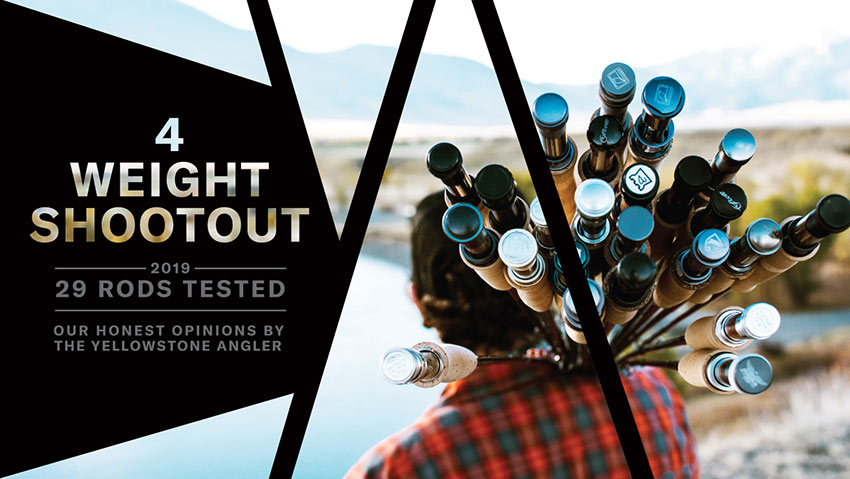
By George Anderson
With comments by the Yellowstone Angler staff
*Note The final results and performance charts on this page are George’s figures. To read each staff member’s casting notes and performance finishing order, please click on their photo above.

It has been several years now since our last 4-weight Shootout, as we have concentrated on both 5-weight and 8-weight rods. We decided it was time for another 4-weight Shootout, since a great 4-weight rod is hard to beat for the angler that loves to fish smaller dry flies.
When I’m fishing the spring creeks here near Livingston, the Railroad Ranch on the Henry’s Fork of the Snake, as well as the flat water on the Bighorn or Missouri rivers, I reach for my favorite rod for this kind of technical fishing, an 8 ½ foot #4.
As I have grown older, I derive a lot of pleasure from stalking and catching rising fish, where the keys to success are casting accuracy and making delicate presentations. Take tricky undulating currents, and then add in a little wind, and getting a fly right in the fish’s window with that drag-free drift becomes quite the challenging task. A great 4-weight rod is the best tool I’ve found to meet these demands.
A 3-weight fly rod can be great fun on windless days, but those days seem to be rare. A good 5-weight rod, which is definitely one of the most versatile you can have in your quiver, just won’t match one of the top 4-weights when it comes to making delicate presentations, or achieving that ultimate drag free drift with a thinner fly line.
A good 4-weight rod must be more than just a dry fly rod though, and the best 4-weights are wonderful rods to use fishing nymphs at shorter distances, and are also capable of pitching smaller streamers when conditions dictate such vile and desperate moves in order to catch fish.
My favorite length for a 4-weight rod is 8 ½ feet. But as you will see in this Shootout, we have not limited our review to just 8 ½ foot rods. There are a few 8 foot and shorter rods as well as a few 9-foot rods in the mix, especially when manufacturers don’t offer an 8 ½ foot model. I do like the 8 ½ foot rods over the 9 footers as they are lighter and the shorter length allows me to strike more quickly, and they often provide better light tippet protection than the longer rods.
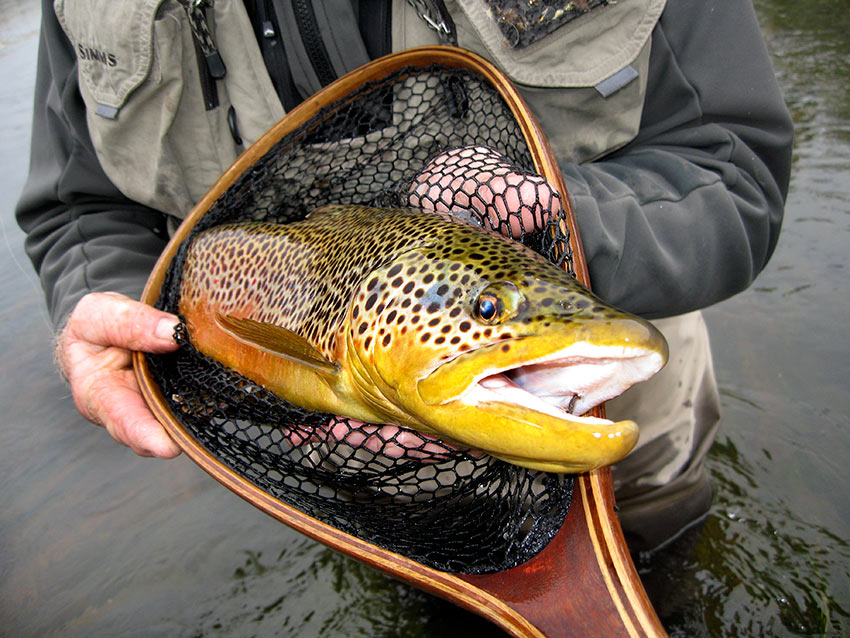
In this year’s 4-weight Shootout, we found that most manufacturers are building more powerful 4-weight rods than in the past. This year, as is the norm in the industry, all of the rods tested are 4 piece rods. These stiffer 4-weight rods require lines that are slightly heavier than a standard AFTMA 4-weight line. In this Shootout, we again used the Scientific Anglers lines, which we have found to cast better and last longer than other brands. For the lighter rods, we used their Amplitude Smooth Trout. We found most rods performed better with the Amplitude Smooth Infinity, which is a half line size heavier. We’ll indicate which line proved best with each rod later in the individual rod write-ups.
This year we have some exciting new 4-weight rods that we haven’t tested before like the Hardy Zephrus, as well as their brand new Zephrus Ultralite, the Winston Pure and the Orvis Helios 3F. Add into the mix the Scott Radian and G-Series, the T&T Avantt, the Sage X, as well as the G. Loomis NRX LP and Asquith, and you have a full array of the best 4-weight rods on the market.
The best 4-weight rods are superb at the short to medium distances, such as the Zephrus, the Pure, the Scott G-Series and the Orvis Helios 3F. For those anglers that like fast action rods with more power, (for fishing at longer distances or in windy conditions), the G. Loomis Asquith, the T&T Avantt, and the Scott Radian are good choices.
We were all especially anxious to see how the Orvis Helios 3F and the new Winston Pure would fare, compared to our favorite 4-weight, the Hardy Zephrus. And what about the new Hardy Zephrus Ultralite, which is insanely light, and on paper looks like it could be the possible winner? Only one way to find out – cast and compare them all.
You will be surprised to see how well mid-priced rods like the Hardy Shadow, the Orvis Recon, and the Douglas DXF performed, all of which made it into our top ten overall in the final results.
Once again we give you a Performance Only chart, which zeros in on the very best performing rods, which is the real meat of our Shootout.
Category changes that improve the accuracy of the results in our latest 4-weight Shootout
For our 4-weight Shootout, once again we have added another performance category – Light Tippet Protection. This is especially important for 3 and 4-weight rods, when you are often using very light 5X, 6x and 7X tippets while fishing small dries, emergers and spinners. Here, the softer rods, ones with softer tips and rods with lighter swing weights post the highest scores.
We deleted our “Perfect 4” performance category, since it seemed redundant, given the fact that we give you our opinions for our favorite 4-weights in the “Fun to Fish, got to have” category. Here, any rods that rate 9.5 -10 are superb, and would be at the top of a Perfect 4 category.
The final change in our performance categories is putting a lower value of 10 points on the longest distance – 60 feet. The best rods certainly need to handle this distance easily, but most anglers are buying a 4-weight rod for fishing at closer distances, which puts the emphasis on 25 to 40 foot casts.
2019 4-weight Shootout Results Summary
1. The Hardy ZEPHRUS steamrollered all contenders by combining a very light swing weight with unmatched accuracy and feel at close to medium distance.
2. Both the new Winston PURE and Orvis HELIOS 3F put in impressive performances, securing podium finishes.
3. The new HARDY ZEPHRUS ULTRALITE was disappointing, mainly due to a slower action than the Zephrus, and a lack of accuracy in close.
4. The Hardy SHADOW at $349.95 takes the crown as our best mid-priced rod with an exceptional performance that put it into a tie for 4th place overall with the T&T AVANTT. The Orvis RECON, at $429 wasn’t far behind!
5. The Fenwick AETOS, at $179.95 is unquestionably our best performing inexpensive rod.
Picking the best 4-weight rod
We see fly rods getting better each year, and today it is often only subtle differences that separate one rod from another. Casting and rating the performance of rods at the different distances is the real meat of our Shootouts. We have found that the only good way to pin down these subtle differences is to have at least a half dozen of the contending rods with the line stripped out and sitting there in front of you on the lawn, so that you can take a few casts with one rod, lay it down and pick up another rod, and make a few casts at the same distance, make some notes and then move on to another rod or the next distance.
Once we determine how the rods perform at the various distances and compile these point values, we then add in points earned from all the other categories to determine the final finishing order.
Keep in mind that what you will read here are only our opinions. I’m sorry if we offend some people or manufacturers. We are just trying to call it like we see it, in an unbiased manner. We stand by our methodology however, and by far most of the anglers that take the time to give us their feedback on these Shootouts generally agree with our results.
Why Trust Our Opinions?
After fifty years in the fly fishing business as a guide, shop manager and shop owner, I’ve learned a lot about what it takes for a fly rod to perform well. I’ve helped many manufacturers like G. Loomis, Sage, Winston, Loop, Douglas, and Scott with their rod design process.
My son, Jamie is also a fanatical fly fisherman and a great caster. He has been a very important and integral part of our Shootouts and tackle comparisons over the years. In addition to being a test caster and editor, he’s responsible for some of the photos and putting all of this on line.
In addition to my comments in the main Shootout, you’ll want to read the comments from Jamie and our other Yellowstone Angler staff members, Logan Brown, Francis Clougherty and Chloe Nostrant. Logan and Francis have worked here for many years and are both great casters and anglers. Chloe has been working in the shop for two summers and now works with us full time. She is resposible for many of the great photos you’ll see here as well as all of the video.
To read their comments, simply click on their photo above at the beginning of our Shootout. Their choices sometimes differ from mine, but we are almost always in general agreement on the top 4-6 rods in the Shootout.

Click here to read Francis’ comments
The best rods are not always the most expensive ones
As you’ll shortly read, our top rated rod, the Hardy Zephrus is $679.00, nearly two hundred dollars less than the next three rods, which are each close to $850.00. The Hardy Shadow that tied for 4th place sells for only $350.00. And the Fenwick Aetos, that finished at 11th, higher than the middle of the pack, is only $179.95!
There is no question that the craftsmanship is better on the very best rods, and with a few exceptions they do perform better than the less expensive rods. Will they make you a better angler? Our answer is a definite yes. Certainly the Hardy Zephrus is a bargain as our choice for as the number one 4-weight rod. Conversely, looking at the most expensive rods in our Shootout, the G. Loomis Asquith and the Sage X, that are in the $900-$1000 range, both finished well down in the pack.
Expensive rods do have that wow factor that will impress your buddies. Are you comfortable showing up with a $200 rod when everyone else has one of those hotshot $750 to $1000 rods in their hands? It’s also nice to look down at your rod and appreciate the craftsmanship as well as its performance. But is that high priced rod really $400-$600 better? Only you can make that decision.
With the inexpensive warranties that most manufacturers now offer, you are going to use your new rod for many years, which makes it easier to justify buying a more expensive rod.
Our advice is that if you feel one of the top rated, expensive rods works best for you, go for it.
Eliminating the variables
As in our past Shootouts, it is important to keep everything apples to apples in an effort to eliminate the variables that will have an effect on the scores. In order to do this, we set each rod up with the same reel, line, amount of backing and leader, length of tippet and the same size yarn indicator.
By having all the rods set up in an identical manner, it is easy to take a few casts with one rod, at say 40 feet, then pick up another rod and do the same without having to strip the line off one rod and take the time to load up another. Also, by having 8-10 rods set up, 2-3 testers can simultaneously do the casting. First we try to determine what we felt were the best performing rods. Then we progressed to the mid-priced rods and finally the least expensive rods. We kept the best rod in each category, high priced, medium priced, and inexpensive category handy for comparison. This made it easy to judge one rod against another. We also kept on hand, and compared, what we felt was the very best rod – the Hardy Zephrus.
For reels, we again decided to use one of our all-time favorites, the Galvan Torque (T-4), loaded with 100 yards of 20 lb. backing and fly line. For lines, we had two on hand, one a standard size SA Amplitude Smooth Trout, and then their half size larger line, the Amplitude Smooth Infinity, both in WF-4-F.
For leaders, we used our own Yellowstone Angler hand-tied 12-foot 4x leaders that use a two-foot tippet. Just about any rod can turn over a 9-foot leader, but only the best casting rods can turn over a 12 footer at short distances. Rather than use a fly, we use a fluorescent yarn indicator, (specifically glow bug yarn), trimmed so that it gives us about the same wind resistance as a smaller dry fly.
Setting up the casting stations
For this Shootout, we were able to do the casting here on our lawn at the shop. We set out three sets of paper plates as targets, with plenty of distance between each casting line so that no one was getting tangled up. For this 4-weight Shootout, we decided to make the short distance 25 feet, the mid-distance 40 feet, and the longest distance 60 feet. With 4-weight rods the emphasis is on the shorter distances, as rarely would an angler be casting a 4-weight at 60 feet or more.
We set the casting line so that we generally had the wind at our back if possible, or at least off our left shoulder (all of us are right handed). In Livingston we usually have plenty of wind, so we had to wait until we got some fairly calm days, to do the casting. I’ve found that it is almost impossible to judge accuracy and presentation if you have strong gusty winds, but having a little wind tells you a lot about how the various rods perform, especially at long distances.
Reels: The Galvan Torque 4 (T-4)
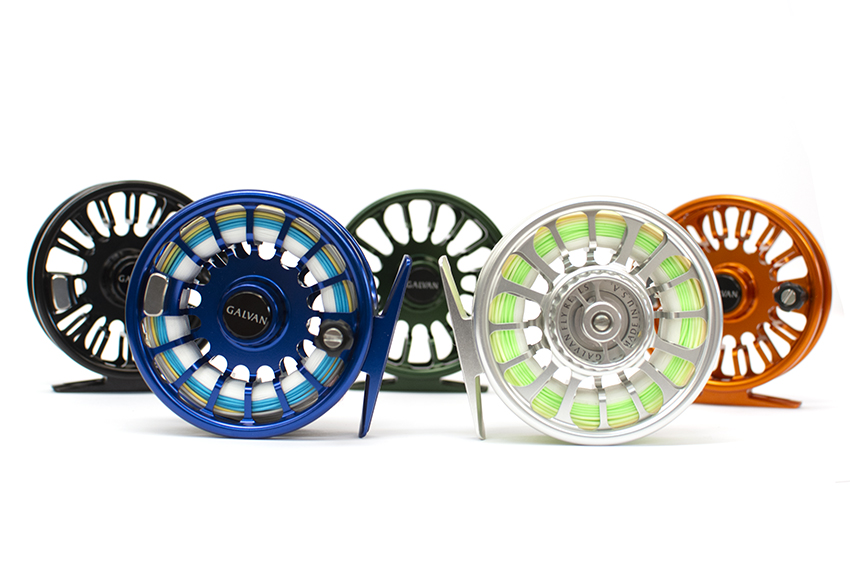
The Galvan reels have been one of our favorite fly reels, and the slightly larger T-5 won our last 5/6 weight Reel Shootout. The Galvan Torque reels have proven to be wonderful reels. They are light but very durable. One of the things I like the most is that they have a large drag knob and a very wide range of drag adjustment. This helps me to easily fine tune the exact amount of drag needed while fishing very light tippets, something that is tough to do with other small reels. Much of the time I’m able to play smaller trout by just stripping line in, but when I hook a big fish that runs hard I want to play it off the reel. Doing this with 6X or 7X tippet demands a good smooth drag with just the right amount of drag adjustment.
Removing the spool requires a simple click of the button on the front side. I love the handle design – it tapers outward allowing you to quickly get and maintain a good grip on the handle. A counterbalance opposite the handle is used to keep the reel running smoothly when a fish is racing away from you. Also, the Galvan Torque reels are basically maintenance free, using a rulon bushing that requires no lubrication. Of all the reels we have carried over the years, Galvan continues to have the fewest warranty issues and returns.
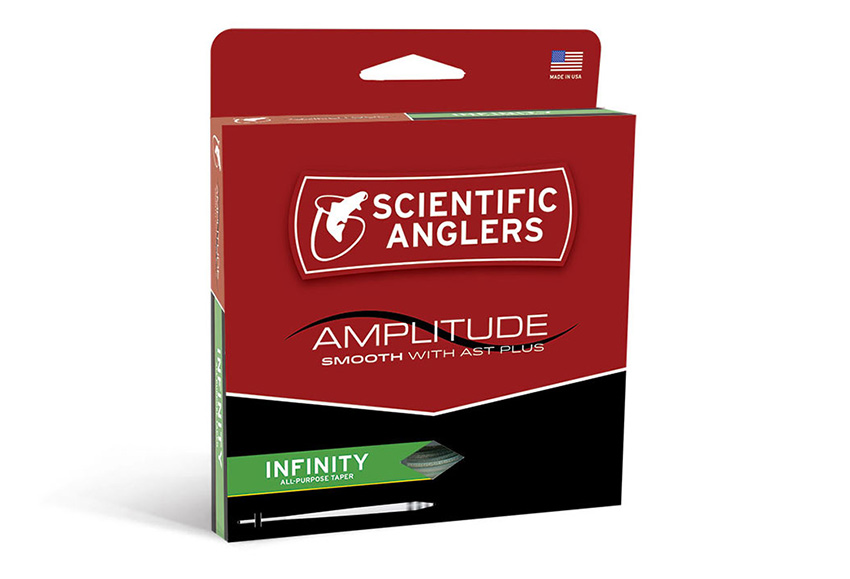
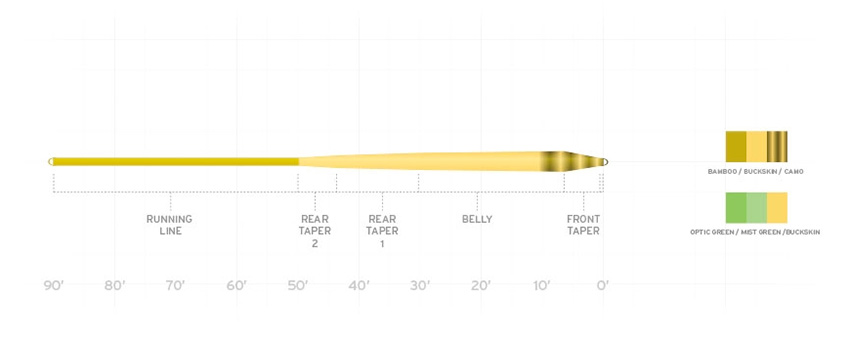
In the past we have used the Scientific Anglers lines since they shoot better and hold up longer than any other line we have found. This year SA has come up with an impressive new line series called the Amplitude Smooth. This is a smooth line, rather than one with a textured coating. I’ve always liked the smooth lines, as they don’t make so much noise running through the guides.
These come in two models, the Amplitude Smooth Trout, which is a standard size line, and the Amplitude Smooth Infinity, which is a half line size heavier. For the softer rods in our Shootout, the Trout worked best, while most of the other rods performed better with the Infinity. We make a note of which was the best line with the write up on each rod.
Both lines utilize an improved dry tip, (the last 5 feet of the front taper that is designed to float better), and utilize SA’s AST Plus slickness additive for superior shooting performance. We can attest to this as these lines shoot like crazy! It is important for any fly line to shoot well, and even “clear well,” when you have extra line at your feet and a fish is streaking for the horizon.
Both of these lines utilize a slightly longer rear taper that allows superior mending ability as well as enhancing the ability to make medium to longer casts. From 25 to the 40-foot mark, these lines were just magical, and stretching the distance out to 60 feet was easier than with a standard belly line.
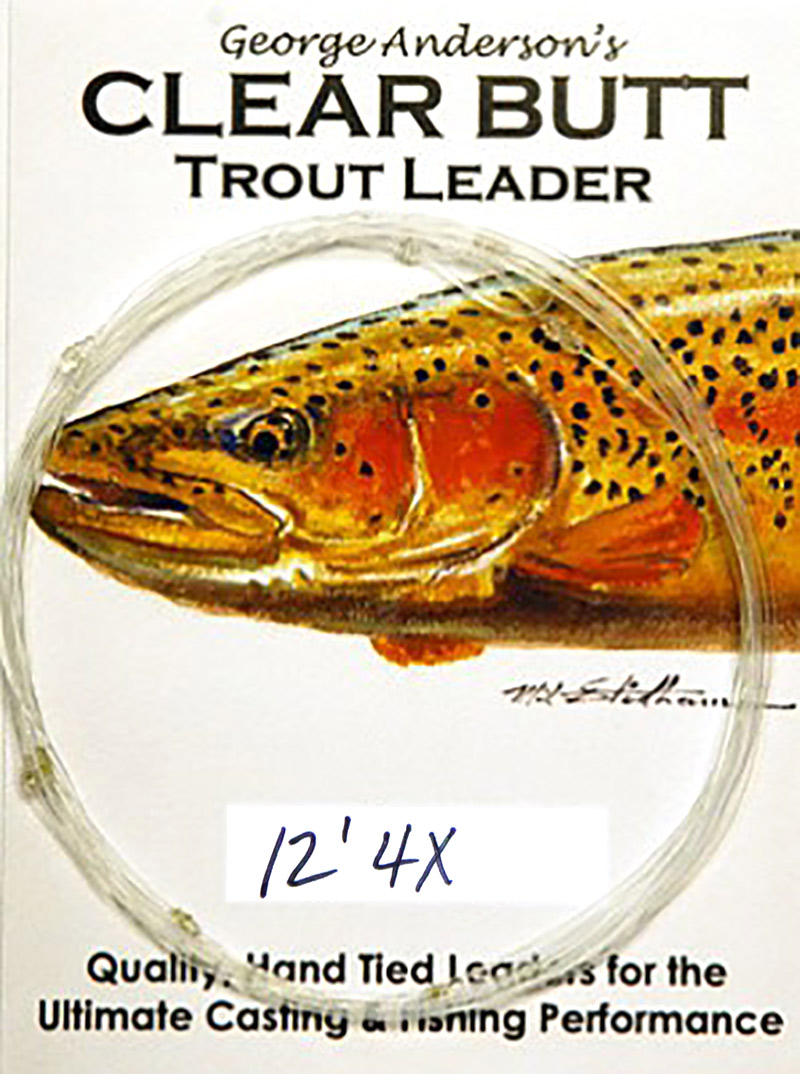
Leaders are a critical element in making accurate presentations and fooling spooky trout. For 4-weight rods, when you are fishing at shorter distances, (most of the time), it is particularly important that leaders turn over well. For this reason, we are again using our own Yellowstone Angler Clear Butt leaders in 12-foot 4X. Sure, most of these 4-weight rods will turn over a 9-foot leader, but having to turn over a 12-foot leader requires a rod to perform at a higher level. A 12-foot leader also gives you a stealthier presentation.
For most of my fishing with a 4-weight rod in critical conditions I’m using one of our 12-foot leaders down to a 5X or 6X tippet, but in the Shootout we stick with 4X Rio Powerflex as a tippet in order to minimize breaking off the yarn indicator. Our hand tied leaders, using stiffer clear Maxima for the butt and midsections, turn over better and more accurately than any of the knotless leaders on the market.
At short distances like 25 feet, you don’t have much line out of the tip of the rod, so the best leaders must flex like an extension of your fly line. The stiffer clear Maxima butt sections on our leaders achieve this. To make it easy to judge the turnover and accuracy, we tie in a small fluorescent yarn indicator at the end of the 2-foot 4x tippet and then trim it so that the wind resistance equates to a smaller dry fly.
When I’m fishing dry flies I’ll use a 12-foot leader most of the time as this keeps the fly line farther away from the fish, minimizing the number of fish you spook while casting. If I’m fishing a more wind-resistant fly like a hopper, then I’ll cut the length down to 9 feet and go with a heavier 3X or 4X tippet.
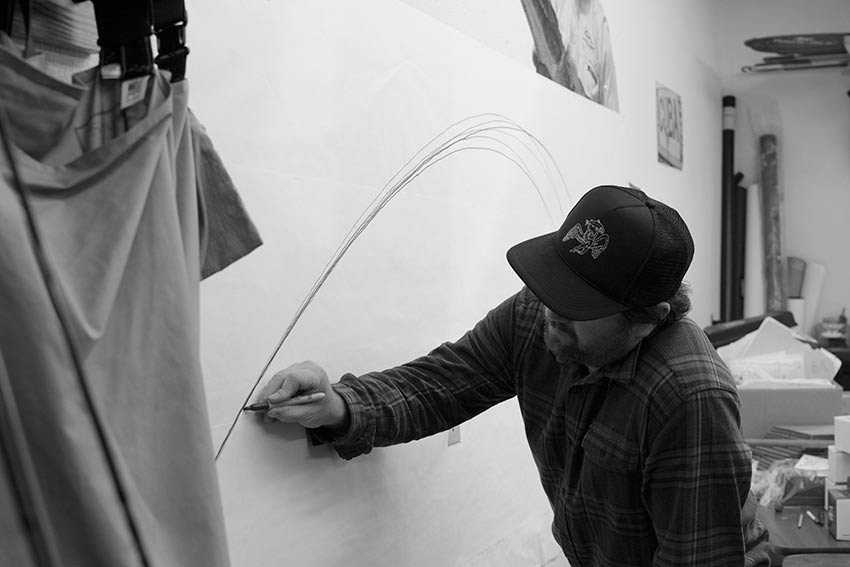
Click here to read James’ comments
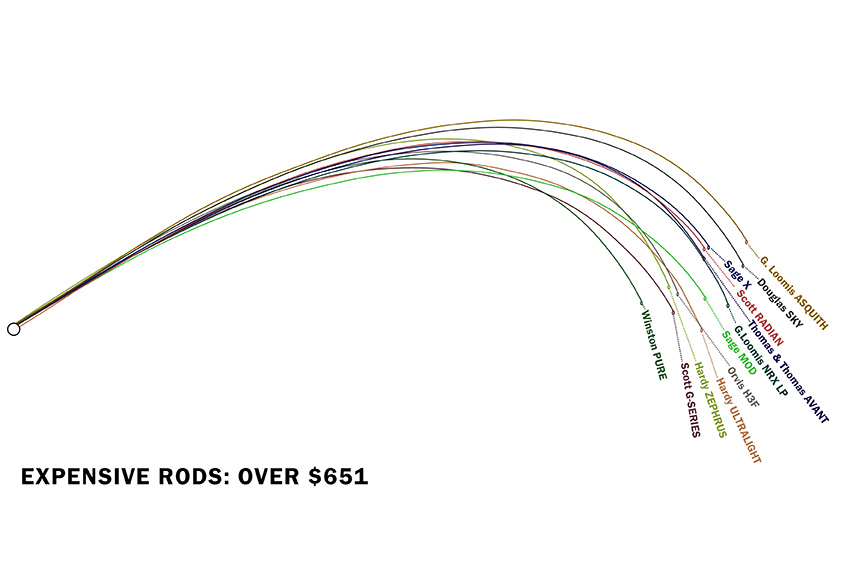
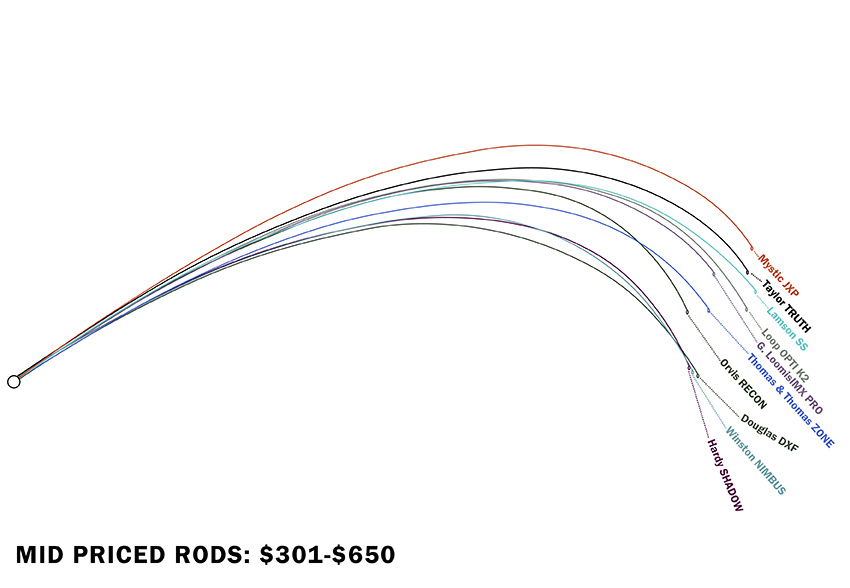
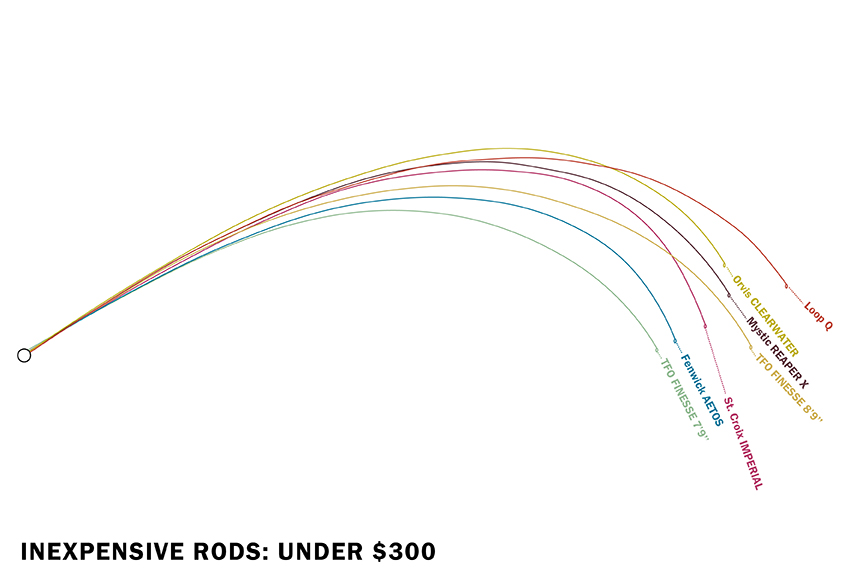
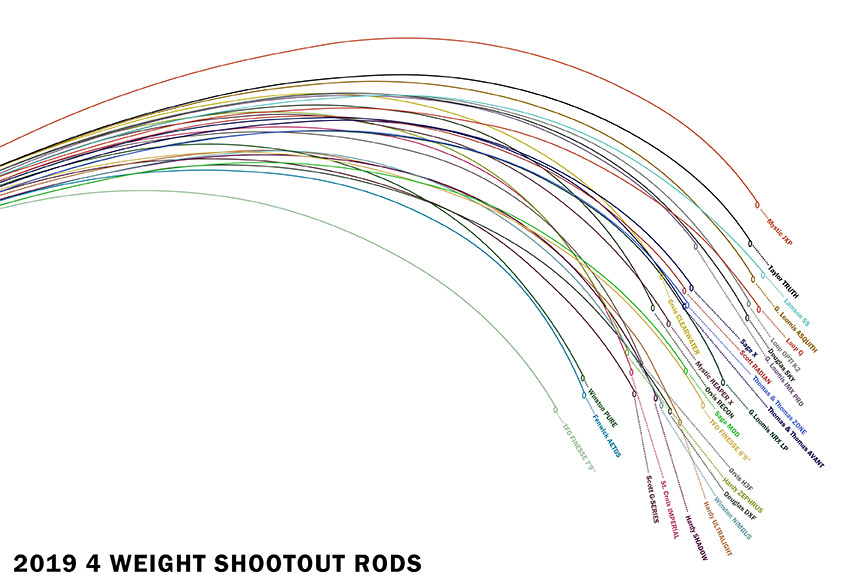
(Click here to see more deflection charts)
Our deflection charts have been very popular in past Shootouts, so we are giving you more this year. Each chart gives you a good look at how the tip section, (approximately the top half of the rod) bends and compares to other rods. Click on any of the charts above to see more charts.
In making the deflection chart, we first put up some white butcher paper on the wall. Each rod is positioned at approximately a 45-degree angle, and then a lead weight of 3.9 oz. is hung from the tip-top of the rod. Finally, we trace the outline of the bend of the rod, first in pencil and then in different colored sharpies.
It is especially interesting to see how the rods compare in stiffness, and how much the tip section bends. This is the best way to examine the action of each rod – the faster action rods have tips that bend more, with stiffer butt and mid sections, while the more medium action rods will have softer butt and mid sections and stiffer tips.
Keep in mind that fast action rods are not necessarily stiff rods as many people assume. The tips on the faster rods bend more. If you look at the best performing rods in general, they have stiffer butt and midsections and softer tips. Perhaps the best example here is our winner, the Hardy Zephrus. It has a butt and mid-section that is stiffer than most rods tested. But that nice soft tip produces great feel and exceptional accuracy. Softer tips on these 4-weight rods almost always equated to better accuracy and more delicate presentations, especially at shorter distances.
Below are all the 4-weight rods in the order they finished. Click on any rod to see the full write up.





























Made in the USA?
We didn’t award any points for this category but we know that for many people this is a factor in a decision to purchase a rod, so we wanted to list this in our Objective Observations table and also in our Final Results table. The G. Loomis Asquith rods are designed here in the U.S. but the blanks are rolled in Japan and then the rod is completed here in the U.S.
Many of the best rods are built in one factory in Korea. Of these rods built in Korea, the Hardy rods are designed in England, the Douglas rods are designed here in the U.S., the Loop rods are designed in Sweden. The Orvis Clearwater rods are designed in Vermont and built in the orient. The TFO rods, the Taylor rods, the Mystic rod, and the Waterworks rods are all designed here in the U.S. and built in Asia.
Explanation of the Points Categories
Price – 10 points available
This one is simple – The least expensive rods get the highest points. Price is always a major factor when buying a rod and as you will see in this Shootout, the best rod was not the most expensive. Sure, the best rods are generally in the higher price bracket, and are usually worth spending the extra dough, even if you have to save up to buy the one you really want.
Often novices entering the sport of fly-fishing opt for one of the least expensive rods, but we’ve found that it makes more sense to spend the money on one of the better performing rods, at least one in that mid-price range, that will allow an angler to develop his or her casting skills much more rapidly.
The result is often that the cheap outfit is mothballed, sold on e-bay or handed down to one of the kids. Don’t make this mistake. With the inexpensive warranties that most manufacturers offer, your new rod is one that will last you for many years. This makes it easier to justify buying the best performing rod. My advice has always been if you can afford it, buy the best performing rod you can find.
If you want to economize, look carefully at both the Hardy Shadow at $349.95 and the Orvis Recon at $429.00. Both offer terrific performance at half the price of the best rods in our Shootout. Moreover, if you want to fish with a 4-weight we consider to be the optimal choice, you don’t have to spend $850, $900, or $1000, but only $679 for the Hardy Zephrus.
Craftsmanship – 10 points available
We are continually impressed by how much rod building craftsmanship has improved over the years. The best Korean built rods now rival what is produced here in the US. Inexpensive rods built in both Korea and China are surprisingly good. Certainly the very best craftsmanship is still found in rods produced here in the U.S. We gave perfect scores to the R.L Winston Pure, the Thomas and Thomas Avantt, and the Loomis Asquith. Also right up at the top are the Scott rods, like the Raidan and G series as well as the Orvis Helios 3F. But in looking closely at the Hardy Zephrus, Ultralite, and the Douglas SKY, they are also definitely near the top end of the craftsmanship ladder.
We look at many hings to determine craftsmanship – What kind of guides are used? We think that the best are the flexible nickel/titanium single foot and snake guides, but these are much more expensive than the heaver, hard chrome versions. How well are the guides wrapped and how nice are the coatings? Nearly everyone is using one-coat epoxy coatings over the guide wraps now, but if these are not very carefully done, they are often sloppy or too much epoxy is applied, adding unnecessary weight. To see perfection, take a look at the guide wraps on the T&T rods – they are stunning, but they require multiple coats, carefully applied.
The quality of the cork in the handles varies enormously among fly rods. The best handles now use a stack of thinner cork rings or standard size rings with very few defects that are laid up individually and then sanded down. These will hold up longer, even with hard usage. Cheaper rods often utilize pre-formed grips that use a lot of filler in the cork that will chunk out or erode with hard use.
Reel seats should lock up easily and hold firmly, without having any tendency to come loose. The rings should be easy to grip and tighten. The best rings use thin nylon spacers between them to assure a positive lock up. Good-looking wood insert spacers that are finished well add to the attractiveness of any rod. Perhaps the best example is the nickel-silver uplocking seat with a gorgeous birdseye maple insert, found on the Winston Pure.
Warranties: 10 points available
Nearly all manufacturers now have some kind of limited “Lifetime warranty.” Well, the Orvis unconditional guarantee is only 25 years. However, nearly all manufacturers are charging a “handling fee” of $25-$100 to repair or replace your broken rod. In addition it will cost you $15 or more to ship your rod in for repair or have your local dealer do it for you. For this Shootout, we again checked the warranty policies in detail, as some have changed slightly. You can read about these warranty policies later in our Shootout.
We have awarded scores emphasizing the lowest repair charges and the quickest repair turn around. To get a 10, repair charges had to be $35 or less with a quick turn around time of less than two weeks. The rods rated 9.5 rods had a $50 fee. Most of the rest score 9’s, which was a $60-$75 fee for repair or replacement. If your favorite rod breaks in the middle of the summer and you don’t get it back for a month and a half, you are going to be very angry!
The Loomis NRX LP gets a perfect score of 10 for their excellent Expeditor repair program which costs $100, but returns the angler a brand new rod, not a repaired one, in just a few days! The Expeditor policy on the IMX Pro is $85.00. This same Expeditor service applies to the Asquith but the fee is $275 for 2nd day air. Because of the cost, we downgraded the Asquith to 7 points. As part of the Expeditor policy, Loomis includes a FedEx call tag so that you don’t have to spend any money to send the broken rod back.
For broken rods that are not registered to the original owners, most companies are going to charge you $150 or more for repairs. Below the final results charts we give you the exact repair charges for each manufacturer.
Fun to Fish/Got to Have – 10 points available
We created this category years ago from the Car and Driver automobile Shootouts. Now that we have dropped our “Perfect 4” category, this category gives you our opinions on the best rods and how they stack up. If a rod looks like a million bucks and casts like it too, fly fishermen are going to lust for it.
Some people might consider high priced rods status symbols. For others, seeing how a rod performs in an expert caster’s hands, convinces them it would make them great anglers as well, or at least take them to the next level. Surprisingly, this is often true. Great rods don’t make great casters, but there is no doubt that they will improve any angler’s casting skills and his ability to catch fish. Don’t fret about the price – you’ll find some ingenious way to sneak it into your collection of rods without the mrs. (or mr.) finding out.
Pick any rod here that we rated a 9.5 or better and you have a winner!
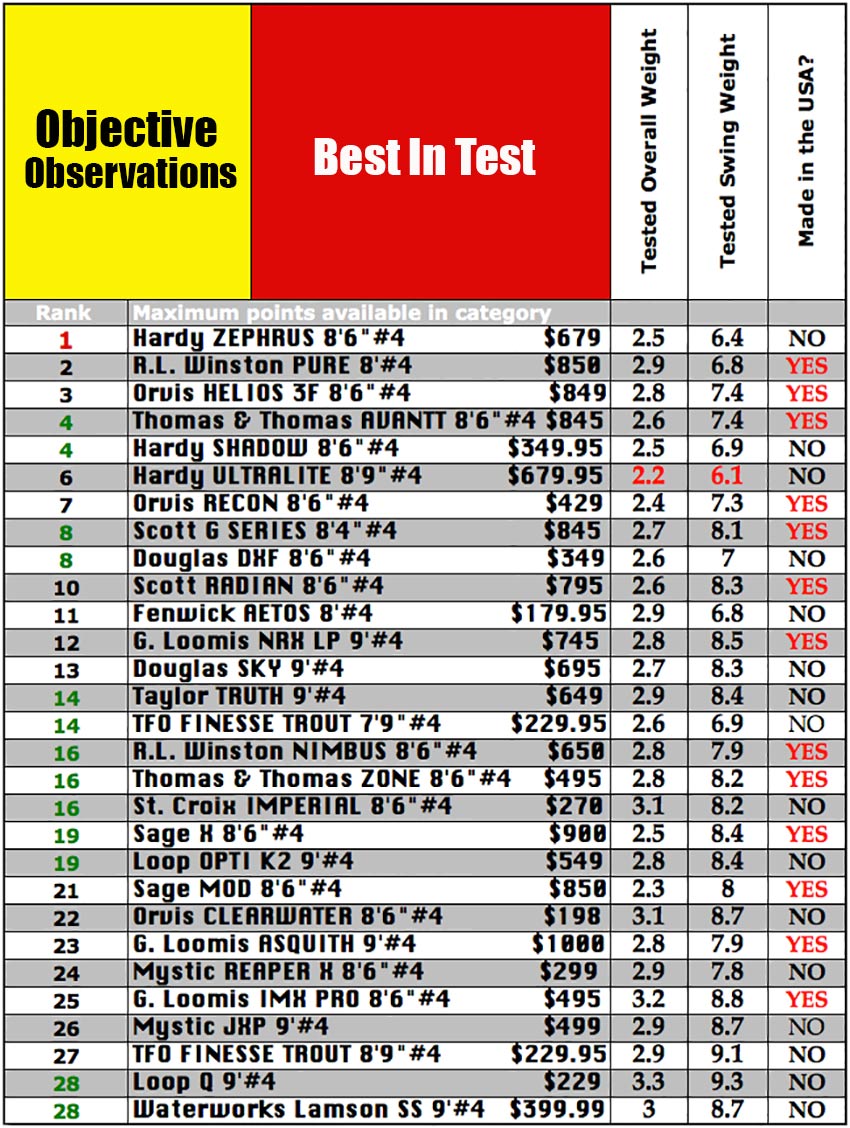
Overall Weight – 20 points available
We have learned that we cannot trust manufacturer’s stated rod weights. As in the past we are using our own Brecknell “official” postage scale to calculate the weight. We simply place each rod horizontally on the scale, read the weight and round it off to one tenth of an ounce. Overall weight is certainly a factor, lighter being better, but swing weight is far more important.
Swing Weight – 20 points available
You are familiar this term if you play golf. It is the relationship of the club head weight to the shaft when you wiggle the club in your hands. We have experimented with the ways to measure this in past Shootouts but we still prefer our tried and true approach using the postal scale since it provides believable and meaningful results.
The swing weight of the rod is the weight you feel out ahead of your hand, holding the rod horizontally. A little wiggle helps you to feel this. Rods with a light swing weight are pleasant and effortless to cast. Ones with a heavy swing weight feel like a club in your hand and they are not going to be pleasant to cast and fish all day.
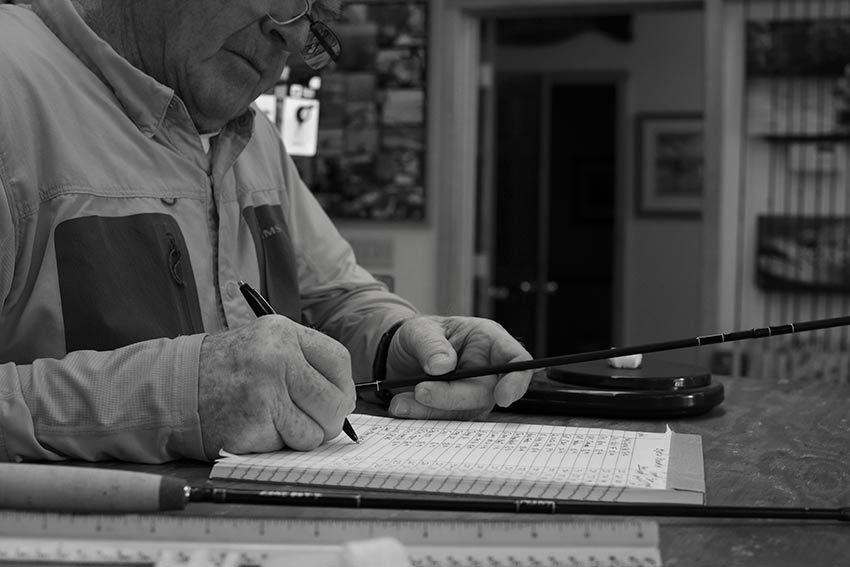
How we compute the swing weight of a fly rod
First, we zero out the scale with a small foam packing pellet in the center of the scale, which we will use for a fulcrum on which to rest the grip of the rod. Next, holding the rod in a horizontally, we position the grip over the foam pellet so that the pellet is centered under the exact spot where you will most likely hold the rod with your hand. For most grips this will be at the midpoint in the swell, or the center of the grip. The idea here is to measure the swing weight at the middle of where your palm is likely to sit on the grip. Once the grip of the rod is placed precisely on the foam pellet, with the rod horizontal, we apply pressure, by pressing down with a fingernail to the very end of the reel seat, and then read (and note) the weight indicated by the scale. It often takes a little time for the rod to “settle down” from all this movement so we do this procedure 4-6 times and then take the average weight we are getting from the scale.
This is a test that anyone can duplicate. Just keep in mind that all these measurements must be made the same day with the same room temperature. We’ve found that fluctuating temperature and humidity from one day to the next can make a difference of .2-.3 oz. However, if all rods are measured on the same day, the relative numbers will be consistent.
In past Shootouts we tried measuring swing weight in other ways, including calculations for the Moment of Inertia, taking the weight of all 4 sections individually and then plugging these figures into an equation. But these methods and calculations were disconnected from what we were actually experiencing in our hand – so, for our last 4 Shootouts, we have gone back to our original method of calculation, explained above.
Light Tippet Protection – 20 points available
Here’s a category that we used in our last 4-weight Shootout, that we deemed important when you are trying to judge the best 4-weight rods, that will often be used with very light 5x, 6x, and 7x tippets. Rods that are light in overall weight and swing weight, and ones that have softer tips, eliminate a lot of break offs caused by an inadvertent heavy-handed hook set. Rods with heavier swing weights or ones with stiffer tips don’t fare nearly as well.
I’ve often had a fish grab a halfway submerged fly in the surface film, when I haven’t been watching closely enough, and bolt off before I could react, snapping my 6x tippet. Rods with softer tips help you avoid break-offs like these. There are lots of ways to break a fish off on light tippet, but the rods that score high in this category are going to give you a far better chance of landing a big fish.
Tippet materials are getting stronger every year, and today we end up fishing 6x, 6.5X, and 7x fluorocarbon a lot of the time, trying to get that perfect drift to entice a big fish to sip in a fly. Using a rod that will dramatically reduce the number of break-offs makes a lot of sense.
Performance at 25 feet – 20 points available
A great 4-weight rod must have the ability to make delicate and accurate presentations with small flies and long leaders at short distances. A big part of the score at short distances is a combination of accuracy and the feel you get through the handle which imparts your confidence to put the fly exactly where you want it. I’m convinced that the key to catching more trout, (and especially larger trout), is casting accuracy. Fly selection is far less important. If you have something about the right size and color, you can often force-feed a selective fish by making repeated accurate and delicate presentations that are right in the fish’s window.
Does the tip of the rod load well enough in close to give you the feel and accuracy you need with little line or only the leader out of the guides? At short range I like to cast off the tip of the rod, using mostly my wrist and little arm movement to power the tip of the rod through the stroke. The best rods in this category are almost always the lightest in swing weight, especially if you are doing a lot of false casting when fishing dry flies.
Performance at 40 feet – 20 points available
With 4-weight rods, performing well at the two shorter distances is the key to determining the best rods. At 40 feet you need a rod that is light and pleasant enough to do a lot of false casting, as you will when fishing dry flies, but you shouldn’t have to double haul to get the rod to perform and hit this distance. The best rods will throw very tight loops at this range with consistently good accuracy. I look for rods that feel totally solid and track well. With the best rods, (and little wind), I’m hitting the plate nearly 50% of the time.
In fishing to wary trout, I often set my false casts up short and to the side of the fish, and then shoot a little line in on that last cast. Rods that have good power and backbone help me fire my cast accurately.
The best 4-weights are also excellent nymph fishing rods at shorter distances. Rods that have good power in the butt and mid-section help me set the hook quickly and allow me to throw a combination of flies and indicator along with a little weight. Good butt power also helps me land fish in a minimal amount of time.
Performance at 60 feet – 10 points available
Since most anglers fish at shorter distances with a 4-weight rod, we decided to put less emphasis on the longest distance, decreasing the points available to 10 points.
The best 4-weights must be able to cast well at longer distances too, and the best rods had excellent loop control and the ability to throw nice tight loops with good accuracy at 60 feet. Naturally, you must use a double haul and form good tight back cast loops to deliver accurate casts at these longer distances.
There are not many situations when you’ll be fishing this far with your 4-weight, but I’ve certainly had many situations, especially fishing dry flies on larger rivers, like the Missouri, where I’ve had to throw it this long yet still get good accuracy and a delicate presentation in order to catch a nice fish.
The best rods in our Shootout can handle this distance with ease, and are actually capable of casting much farther in an expert caster’s hands. I felt the best rods at long range were the Helios 3F and the Loomis Asquith, as well as the T&T Avantt and the Scott Radian.

Click here to read Logan’s comments
Manufacturers’ Warranties Explained
Here is a recap of each manufacturer’s current policy, their latest fees and what we have experienced for repair time required. Remember that it will cost you an additional $15 or more to send your rod in unless you are using the G. Loomis Expeditor program.
Douglas – Lifetime warranty. $35 handling fee. Rods are repaired, not replaced unless broken. Usually takes 1-2 weeks.
Fenwick- Lifetime warranty. $25 handling fee. Broken sections are replaced. Sometimes the whole rod is replaced. If Fenwick determines that there was a defect, the rod will be repaired or replaced at no charge. Usually takes 2 weeks.
Hardy – Lifetime warranty to original owner. $75 handling fee. Rods are repaired or sections replaced. Shipping is from their US warehouse, usually takes 2 weeks.
G. Loomis – Lifetime warranty to original owner. If you feel your rod has broken because of a defect, you pay to send the rod to their warranty dept. and they examine it. If the rod is broken because of a defect, or while fishing, replacement is free. No handling fee. If broken from neglect or any other cause, you must use the Expeditor service. You call in and incur a credit card of $100 but you get a brand new rod in 3-4 days. The Expeditor service for the NRX or NRX LP rods is $100, while the IMX Pro rods are $85.00. The Expeditor service fee for the Asquith rods is $250.00 for ground or $275 for 2-day air. With your new rod they include a FedEx call tag so that it does not cost you anything to return your broken rod.
Loop – Lifetime warranty to original owner. $60 handling fee. Rods are repaired or sections replaced. Same day or next day shipping if they have the parts in stock, if not, usually takes 2 weeks.
Mystic – Lifetime warranty to original owner. $50 handing fee. Rods are replaced. Usually takes 1-2 weeks.
Orvis – 25 year warranty to original owner. $60 handling fee. Rod is repaired, or sections replaced. Usually takes 2-4 weeks.
Sage – Lifetime warranty to original owner. $25 handling fee on current rods. $75 on recent rods within 10 years, $125 on classic older rods. Rods are repaired, not replaced except for broken sections. Often takes 4-6 weeks.
Scott – Lifetime warranty to original owner, $50 handling fee. Rods are repaired, not replaced, except for broken sections. Usually takes 2-4 weeks.
St. Croix – Lifetime warranty to original owner, $85 handling fee. Rods are repaired, not replaced except for broken sections. Usually takes 2-4 weeks.
Taylor – Lifetime warranty to original owner. One year warranty on hardware and guides. $50 handling fee. Rods are repaired or replaced. Usually takes 1-2 weeks.
Temple Fork Outfitters (TFO) – Lifetime warranty to original owner. $35 handling fee. Rods are either replaced with a new rod or the broken section is replaced. Usually takes 1-2 weeks.
Thomas and Thomas – $55 repair charges for the original owner, includes shipping. Non-original owner $150 per section. You must register the new rod within 30 days.
R.L. Winston – Lifetime warranty to original owner. $75 handling fee to original owner, $150.00 charge to all others. Rods are repaired, not replaced. Usually takes 4-6 weeks. New rods must be registered at time of purchase.
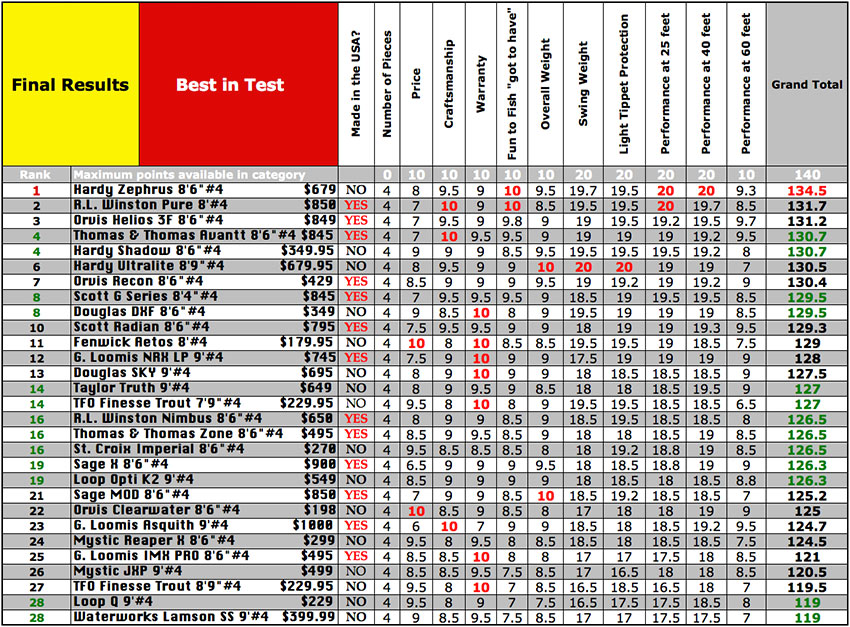
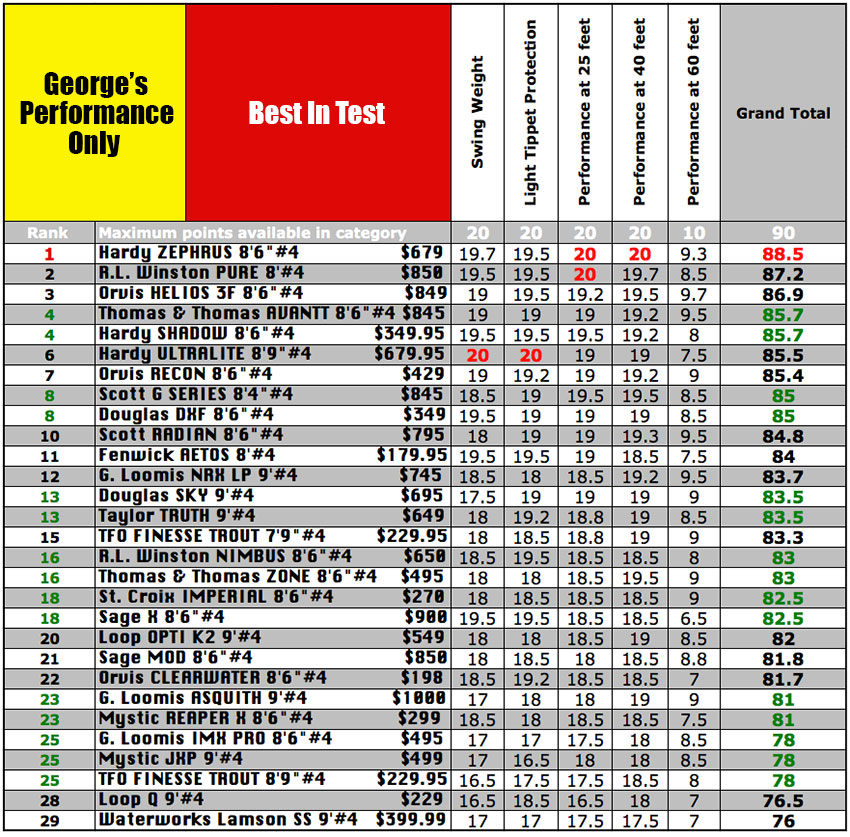
#1 Hardy ZEPHRUS 8’6” #4 $679.00
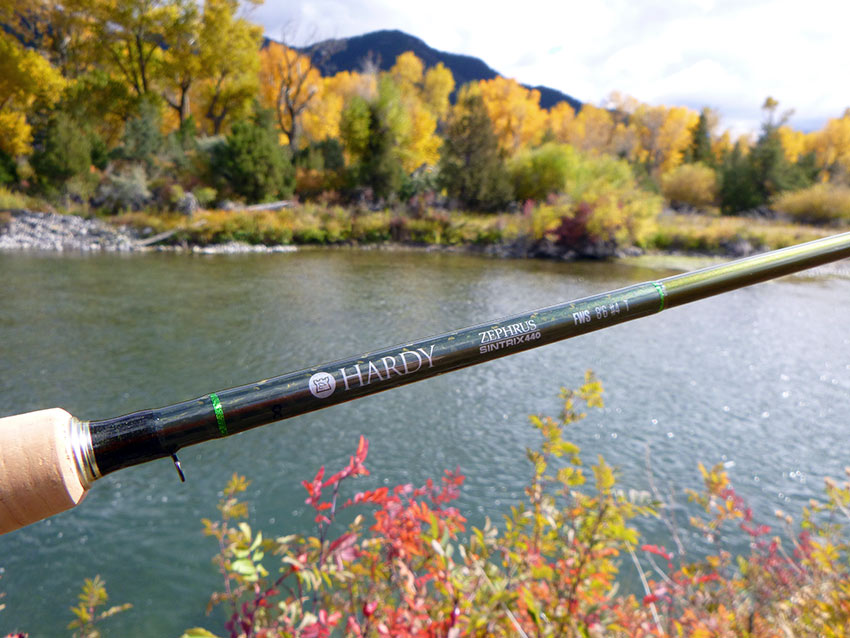

Hardy has given us another magical rod that produced an absolutely stunning performance to blow away all the contenders. When you read everyone’s comments on the Zephrus, you will see that we all agreed that this is a very special rod, for a variety of reasons.
Howard Croston, Hardy’s rod design genius in England, has given us another outstanding rod that performs extremely well at all distances. I’ve fished with Howard here, on our Montana Spring Creeks, and better understand how and why he came up with these designs. Howard is a great angler and knew just what he wanted for the perfect 4-weight.
To improve on the previous Zenith, which won our original 4-weight Shootout, Howard gave the Zephrus a slightly stronger butt and mid section as well as a softer tip.
He wanted another 4-weight that was very accurate and delicate, yet one that had more power in the butt and mid-section. If you look at the deflection chart, you’ll see that the Zehprus has one of the stiffest butt and midsections, yet then it progresses to a nice soft tip.
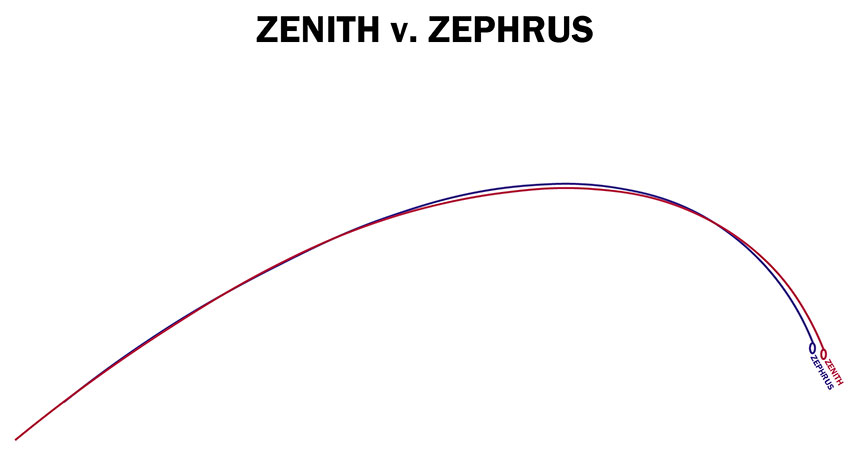
I’ve fished this Zephrus myself for the past two years, and it has been my go-to rod when I’m fishing small dries, emergers and spinners in the surface film. Nothing I’ve cast yet is better in terms of feel and accuracy from in close right out to 40 feet. This rod gives me the confidence that I can place the fly just where I want it, and do it with a delicate presentation. But when I need to reach out and make casts at 60-70 feet, as I often do fishing bigger rivers like the Missouri, the Zephrus has tons of power on tap to get the job done.
When you pick up this rod, you’ll first notice how light it is in swing weight. Part of the light swing weight can be attributed to the use of the superb REC nickel/titanium single-foot guides. These are very light, and will flex but never break.
One SiC style stripping guide is used as well as a hook keeper. Hardy uses a comfortable half wells, western style handle and the quality of the cork is superb. The color of this rod is an attractive olive, with the guides wrapped in dark brown. An attractive X-pattern graphite wrap is used on the butt, behind the logo. The epoxy coatings on the guides are top notch. I also like the alignment dots. The reel seat is a double uplocking skeleton seat in anodized gold, with a pretty wood burl insert using green and brown highlights to complement the blank. The overall craftsmanship is excellent.
The perfect line: SA Amplitude Smooth Infinity in WF-4-F
George’s casting notes:
Performance at 25 feet: 20 points out of 20
I love the light swing weight. The nice soft tip allows me to cast off the tip of the rod with a flick of my wrist. Both the feel and accuracy were outstanding. I was hitting the plate almost every time.
Performance at 40 feet: 20 points out of 20
I’m getting effortless tight loops, and I had complete confidence on where the fly was going on every cast. The light swing weight made casting effortless, and I’m getting excellent accuracy combined with delicate presentations. Nothing beats this rod at 40 feet.
Performance at 60 feet: 9.3 points out of 10
The ability of this rod to track precisely combined with its ability to form beautiful tight loops allowed it to perform almost as well as the best rods at long range.
#2. R.L. Winston PURE 8’ #4 $850.00
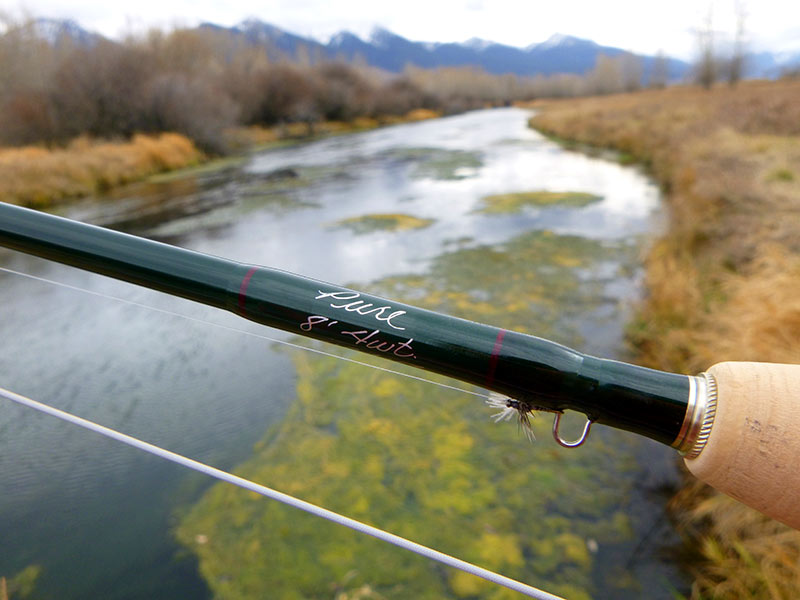

The Pure is a brand new rod from Winston. We knew it would be good when the Pure won an award for the Best New Freshwater Rod at the 2018 IFTD show in July. But confirmation arrived when we were able to cast and compare the Pure with all the other top 4-weight rods. The Pure puts in an impressive performance, especially at the shorter distances, and finishes in 2nd place in both the overall and performance results.
We actually cast two #4 line Pure rods- the 8 footer you see here and its 8’6” brother. I normally prefer an 8 ½ foot rod in a 4-weight but when we cast the two rods heads up, and put them on the deflection board, it was obvious that these rods had two different actions. The 8 ½ foot rod had a much slower action and a stiffer tip than the 8 footer, and didn’t cast nearly as well. Everyone here at our shop liked the 8 footer better, so we put only the 8-foot model in this Shootout.
This 8 foot Pure is somewhat like the Zephrus in acti0n with a fairly strong butt and mid section and then a nice soft flexible tip. This fast action produced extremely good feel and accuracy, especially at 25 feet. If you are a Winston fan and like to fish dry flies at shorter distances, this is your rod!
Annette McLean, Winston’s long time rod designer did a great job with the Pure, giving us a rod that is Pure fun to cast and fish. Winston says “Pure Feel, Pure Presentation and Pure Fun” I can’t disagree. This is a light rod in swing weight – almost as good as the Zephrus. Of course it is six inches shorter too. The 8 ½ foot Pure had a much heavier swing weight, and would not be as much fun to false cast all day as this 8 footer. Our reasoning in this Shootout was to pick what we felt were the BEST 4-weight rods, regardless of length, and there no question in our minds that the 8 foot Pure is Winston’s best 4-weight rod.
The Pure is unquestionably one of the best looking rods in our Shootout, with some of the best craftsmanship. The blank is that same lovely emerald Winston green we have come to know and love. Get this rod out in the sunlight and it really lights up. The wraps are a dark green to complement the blank and the epoxy coatings are perfect. The handle is Winston’s familiar cigar grip, a half wells with a little flare on the bottom end to accept the uplocking seat. The swell in the middle of the grip is a little more forward than most. Nickel silver is used for the winding check and rear grip check as well as the hardware on the reel seat, which is a sliding band and one wide locking ring. The locking ring is a little harder to grip and tighten than others. A beautiful birdseye maple insert is used. This is a classy reel seat, which is much better looking than some of the anodized aluminum insert seats. A hook keeper is used along with a single chrome SiC stripping guide. The rest of the guides are hard chrome snake guides with nice, small diameter wire snake guides on the upper two sections. More manufacturers should use light guides like this to minimize swing weight if they aren’t using the more expensive nickel-titanium guides.
The perfect line: SA Amplitude Smooth Trout in WF-4-F
George’s casting notes:
Performance at 25 feet: 20 points out of 20
Matches the Zephrus in close in terms of casting accuracy and feel. No other rods were as good. Like the Zephrus, casting off the tip of the rod was easy and fun and I was getting very delicate, precise presentations.
Performance at 40 feet: 19.7 points out of 20
The ability of this rod to form and maintain very tight loops helped it give me slightly more accuracy than the Helios 3F or Scott G series at mid-range. The feel was also superb, giving me confidence in the direction of my cast.
Performance at 60 feet: 8.5 points out of 10
At long range, the lack of power now becomes evident. As long as there wasn’t much wind I could easily hit 60 feet but accuracy suffered.
#3. Orvis HELIOS 3F 8’6” #4 $849.00
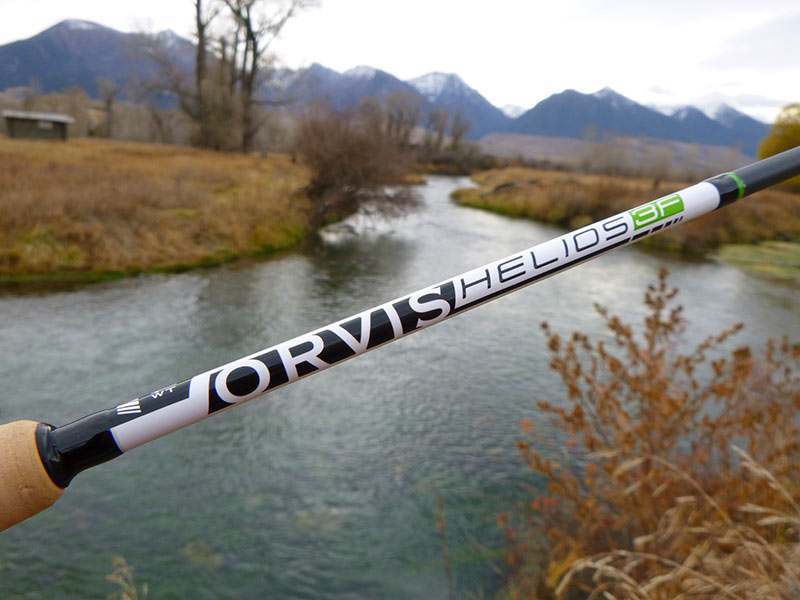

The Helios 3F is a relatively new rod from Orvis and it impressed us with its ability to perform well at all distances. The Helios 3 rods are available in both the D and F Series – with the D series more designed for distance and power. The F Series, concentrates more on finesse, without sacrificing too much power. We felt the 8’6” Helios 3F was the best rod to test since the 3D is available only in a 9-foot model.
I love the feel of this rod – it is nice and light in hand, and the action is fast and seems about right. The action is slightly slower than the Zephrus though, and this contributed somewhat to its lack of feel and accuracy at 25 feet. The swing weight is light but it can’t match the Zephrus or Pure.
This is a very pleasant rod to cast, and I was especially impressed at what nice tight loops I was getting at long range, where it proved to be better than any other rod tested, even the powerful Asquith.
The craftsmanship is typical Orvis excellence. Personally I don’t care much for the five inches of white just above the cork handle but this has been the Helios 3 trademark and I think that Orvis feels that it will help the rods visibility on the rod rack in fly shops or out on the stream. I just don’t think the 3Fd is nearly as good looking as some of the more traditional looking rods, in our Shootout like the Scott, Winston, T&T, and Hardy.
The blank color is a non-glare, graphite gray with slightly darker gray wraps and alignment dots. The epoxy coatings were excellent. The cork handle is a half wells with a long taper at the front, that I found to be comfortable to grip. Quality of the cork was excellent with a stack of thinner rings. The reel seat is an uplocking black anodized skeleton seat with a dark gray graphite insert, (pretty plain looking but it works well). The double size uplocking ring was easy to grip and tighten. One SiC stripping guide is used and the rest are the best nickel/titanium and flexible snake guides in a gray color which complement the blank. I wish there was a hook keeper, which I find very useful on light rods, but there is none.
The perfect line: SA Amplitude Smooth Infinity in WF-4-F
George’s casting notes:
Performance at 25 feet: 19.2 points out of 20
Good, just not nearly as precise but the Zephrus and Pure. I think that the vague feel I was getting hurt here. Swing weight was light but not as good as the Zephrus or Pure.
Performance at 40 feet: 19.5 points out of 20
Now I’m getting nice tight loops, and the rod tracks very well with better feel and accuracy. Casting against the Scott G series it felt about equal, and better than the Asquith.
Performance at 60 feet: 9.7 points out of 10
Feels great out long! Nice tight loops and good control. This rod gave me better control and accuracy at long range than any other rod in our Shootout.
#4 (Tie) Thomas and Thomas AVANTT 8’6”#4 $845.00
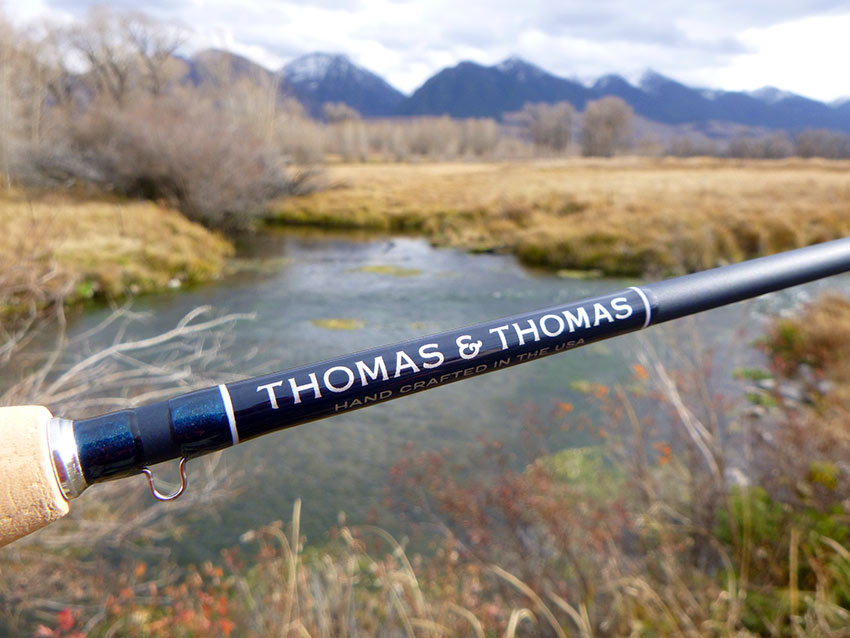

We have been impressed with the Avantt in the 5-weight, and the 4-weight is another terrific rod. This is a fast action rod, a tiny bit stiffer and a tad slower in action than the Helios 3F, but still a very good casting rod. The stiffness hurt in close but this is one of the very best performing rods at long range.
The Avantt matches the Helios 3D in swing weight and feels nice and light in hand. This rod is a pleasure to cast, and it has tons of reserve power at long range. If you find yourself fishing more hoppers and larger dries, you will like this rod as it will really fire them in there with authority. Unlike some of the stiffer 4-weights, this rod performs well at the shorter distances too.
This is one of the best looking rods in our Shootout. Craftsmanship is second to none, and is what we have now come to expect from T&T. The Avantt tied the Pure for the only perfect scores in Craftsmanship. The thing that amazes me is how perfect the guide wrapping and epoxy coatings are, compared to other rods. T&T uses multiple coats to produce a finish that is simply beautiful. No other rod maker does this better.
The blank is an attractive dark blue, with a matte non-glare finish. The wraps are a slightly lighter blue, trimmed with white on the butt section. One thing I like is that there is a serial number on each rod section. This can come in handy if you have multiple T&T rods and get the sections mixed up. The cork handle is a western style grip with a flare on the lower end to accept the uplocking seat, and a nice taper forward providing a very comfortable grip. T&T also uses a stack of thinner cork rings and the quality of the cork is as close to perfect as you can get. The uplocking skeleton seat is anodized in a dark gray to complement the blank with a beautiful piece of black ash burl for the insert. A sliding band and one easy to grip locking ring are used.
A hook keeper is used just above the handle, and the one black SiC style stripping guide is followed with silver hard chrome snake guides, that are small and light out on the tip. In all, this is an extremely attractive rod.
The perfect line: SA Amplitude Smooth Infinity in WF-4-F
George’s casting notes:
Performance at 25 feet: 19.0 points out of 20
Light in hand but the stiffness in the tip is not giving me as much feel in close as the Zephrus, and the accuracy is not as good as the best rods.
Performance at 40 feet: 19.2 points out of 20
I love the way this rod tracks and the accuracy is good too. I still had to give the edge to the Zephrus and Pure. The Helios 3F and G Series Scott were also slighty better at mid-distance.
Performance at 60 feet: 9.5 points out of 10
This is one of the best rods at long range. Tracks beautifully with nice tight loops that are giving me great accuracy.
#4 (Tie) Hardy SHADOW 8’6” #4 $349.95
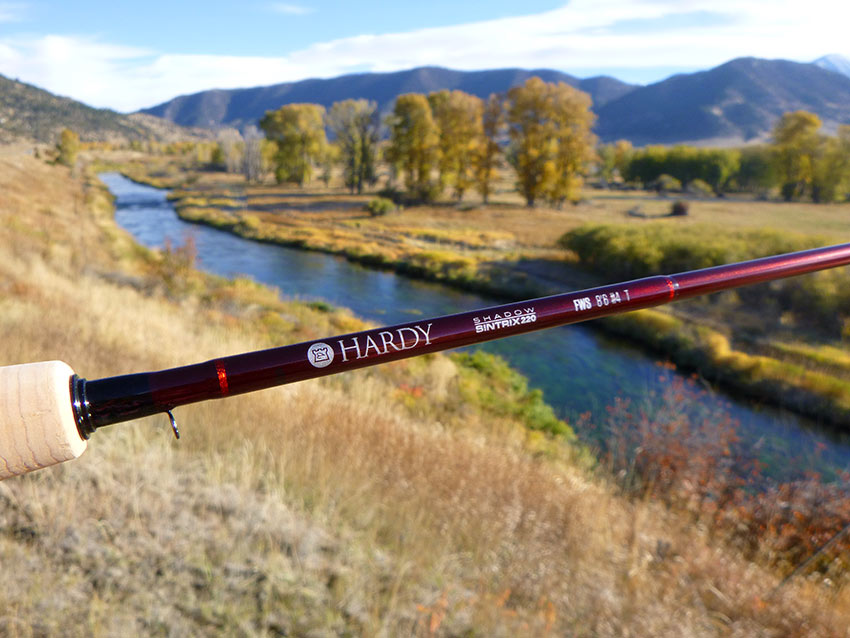

Wow – It is hard to believe that this mid-priced Hardy finished up with the top rods! But there are a lot of good reasons. First, it is very light in swing weight and the fast action is a lot like the Zephrus in that it has a stronger butt and much softer tip than most of the other rods. On the deflection board, the Zephrus had a stiffer butt and mid section and the tip bent a little more, so it is slightly faster in action than the Shadow.
Hardy uses their Sintrix 220 in this rod, a lower modulus graphite than the Sintrix 440 used in the Zephrus, but it provides easy loading yet a sharp recovery. Surprisingly, even using this lower modulus graphite that should be heavier, the overall weight and swing weight are very good compared to our other top 4-weight rods.
Since this is a softer rod than the Zephrus, we settled on using the lighter Trout line but this rod had the power to handle the heavier Infinity nearly as well. I loved the punch and power I was getting with the Shadow and only at long range did it suffer.
There is no question that the Shadow is our best “Mid Priced” 4-weight rod. For the price, it can’t be beat.
This is a sharp looking rod. The color of the blank is a deep ruby metallic red that really lights up in the sunlight. Wraps are a darker red, (almost black), trimmed in brighter red on the butt. Hardy’s half wells cork handle is used, similar to the Zephrus. The quality of the cork is superb. A black anodized double uplocking seat is used with an attractive wood burl insert. The guides start out with a small hook keeper, then a single SiC stripper, followed with black, hard chrome single-foot guides.
The perfect line: SA Amplitude Smooth Trout in WF-4-F
George’s casting notes:
Performance at 25 feet: 19.5 points out of 20
I’m amazed that I can cast off the tip nearly as well as the Zephrus. The feel is perhaps not quite as good, but the accuracy is excellent. Even better than the Helios 3F.
Performance at 40 feet: 19.2 points out of 20
This rod gives me a nice light feel in hand, and I’m getting good loop control combined with plenty of power and good accuracy. Feels equal to the Avantt and Recon at mid distances.
Performance at 60 feet: 8.0 points out of 10
Only out long did I feel at a disadvantage to the best rods and I think part of this was due to the lighter Trout line. With the Infinity it cast better long, and I would have scored it closer to 9 at long range.
#6. Hardy ZEPHRUS ULTRALITE 8’9” #4 $679.95
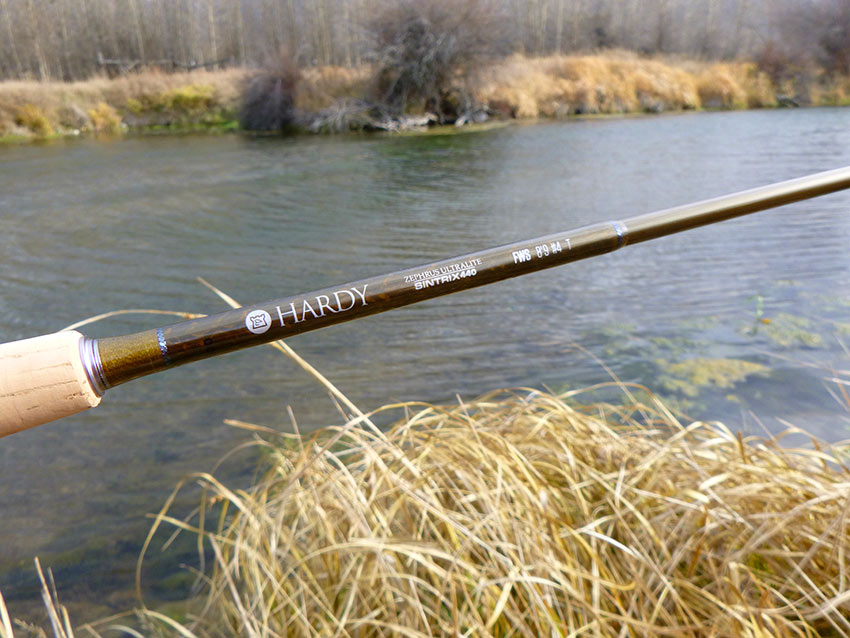

When we first saw this new rod from Hardy, we all had two impressions: 1. Wow –It is super light in hand, and 2. The cork handle is too thin, (for most anglers). Still, I felt it could be our 4-weight winner until I finished casting the Ultralite heads up with the winner, the Zephrus. At short and medium distances, it has great feel, but was lacking in accuracy. I think that this can be attributed to the slower action of this rod compared to the Zephrus. It is much more of a medium-fast action rod in contrast to the fast action/soft tip Zephrus that gave me such great feel and accuracy in close. The Ultralite has a proportionally stiffer tip than the Zephrus, and much softer butt and mid section. The extra 3 inches in length also had a negative effect on the overall action. In close, I could not cast off the tip of the Ultralite nearly as well as with the Zephrus. And since it was such a soft rod, the lack of butt and mid-section power killed its score at 60 feet, especially if there was any wind. I’d like to see Howard Croston re-design this rod with a softer tip. That might be the answer, but then it would likely be more of a 3-weight rod than a 4-weight. Hardy is using their best Sintrix 440 graphite in this rod, also used in the Zephrus.
The Ultralite did get perfect scores for overall weight, swing weight and light tippet protection and these all helped to boost its final scores in both the overall and performance results. But if you look at just the three distance performance scores, it would have finished below the top dozen rods!
The Ultralite is a very attractive rod. The blank is finished in a medium brown with brown wraps that complement the blank. A half wells cork handle is used, but the size is a little small in diameter as I noted. The thinner cork handle may actually be an advantage for some anglers, especially children or women with smaller hands. Standard corks are used and the quality is excellent.
The skeleton uplocking seat is one of the most unusual I’ve seen. It is a double uplocking, anodized gray seat with an attractive burl insert, but right under where the reel seat fits, they have cut away both the threads and the burl leaving the blank that is covered with composite cork! Very tricky and very attractive. The cutout only extends down to ¾ ” from the butt cap, leaving that last portion fully threaded where you would tighten down the rings.
Like the Orvis 3F, there is no hook keeper. Why? I think a hook keeper is very useful on trout rods. The rest of the guides start with a single wire recoil stripper like G. Loomis uses, (I don’t like these much either), but at least the rest are the good flexible nickel/titanium single-foot guides, as on the Zephrus, in a black color.
The perfect line: SA Amplitude Smooth Trout in WF-4-F
George’s casting notes:
Performance at 25 feet: 19.0 points out of 20
I’m having trouble casting off the tip well and this is hurting the accuracy. Feel is good and the rod is very light in hand.
Performance at 40 feet: 19.0 points out of 20
Accuracy is good, just not great. I don’t have the feel I can place the fly just where I want it, as I can with the Zephrus. Casting head to head, the Zephrus, Pure and Helios 3D are all a lot better.
Performance at 60 feet: 7 points out of 10
This rod is so soft that I just don’t have the power in the butt and mid sections to get good tight back cast loops, or the line speed I need to get the job done.
#7. Orvis RECON 8’6” #4 $429.00
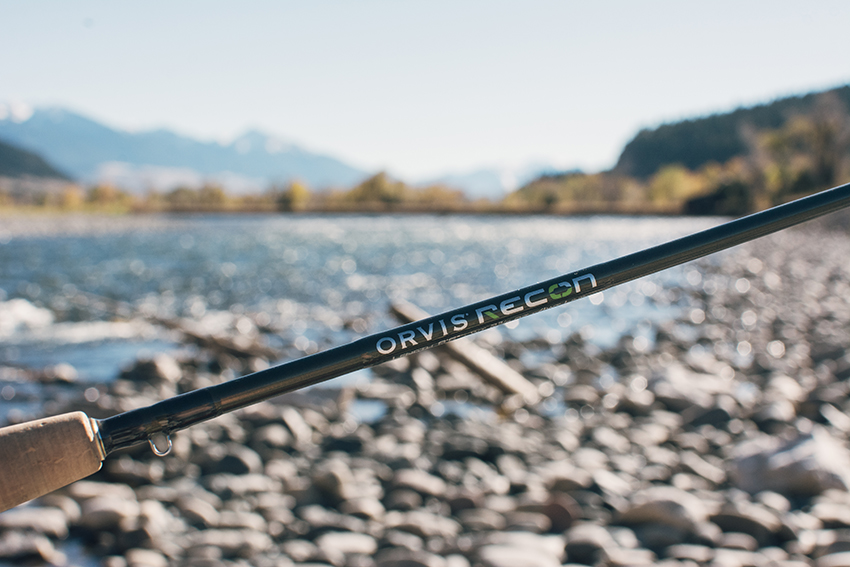

The Recon has been one of our favorite rods, and this 4-weight version is terrific. It comes in very close to our mid-price winner, the Hardy Shadow. In terms of performance, the Recon was actually better at mid to long range. The medium fast action of the Recon is very similar to the Helios 3F and this is one reason it performs so well. And for a rod that is half the cost of the Helios 3F, the overall weight and swing weight are actually lower! I don’t know how Orvis pulls this off, but we like the results.
The Recon is a very pleasant rod to cast – wonderfully light in hand, and responsive. It tracks well and I was getting very nice loops and good control, especially at mid to longer distances.
The components are not in the same class as the Helios 3F, but that is to be expected considering the price.
The color of the blank is an olive green that Orvis calls “shadow green.” The wraps are brown and the epoxy coatings are OK but a little heavy and not nearly as well done as on the 3F. The cork handle is a half wells design with a stack of thin corks as on the Helios 3F. The quality of cork was excellent. The reel seat is a gray anodized double uplocking skeleton seat with sliding band and darker wood insert. The lock rings were a little harder than most to grip and tighten. I thought the larger, wider single ring on the Helios 3F was much easier to grip and seemed to lock up better.
For guides, there is a hook keeper, (The 3F has none), a single SiC stripping guide is used followed with hard chrome snake guides. I found the alignment dots handy.
The perfect line: SA Amplitude Smooth Infinity in WF-4-F
George’s casting notes:
Performance at 25 feet: 19.0 points out of 20
Pretty good, but not quite as accurate or as much feel as with the Shadow. The Scott G series was definitely better.
Performance at 40 feet: 19.2 points out of 20
I’m getting nice loops and good control, but at mid-range the 3F and Scott Radian were better. Overall a very good performance.
Performance at 60 feet: 9.0 points out of 10
Good, just not nearly as solid or as accurate as the 3F or Radian at long range.
#8. (tie) Scott G SERIES 8’4” #4 $845.00
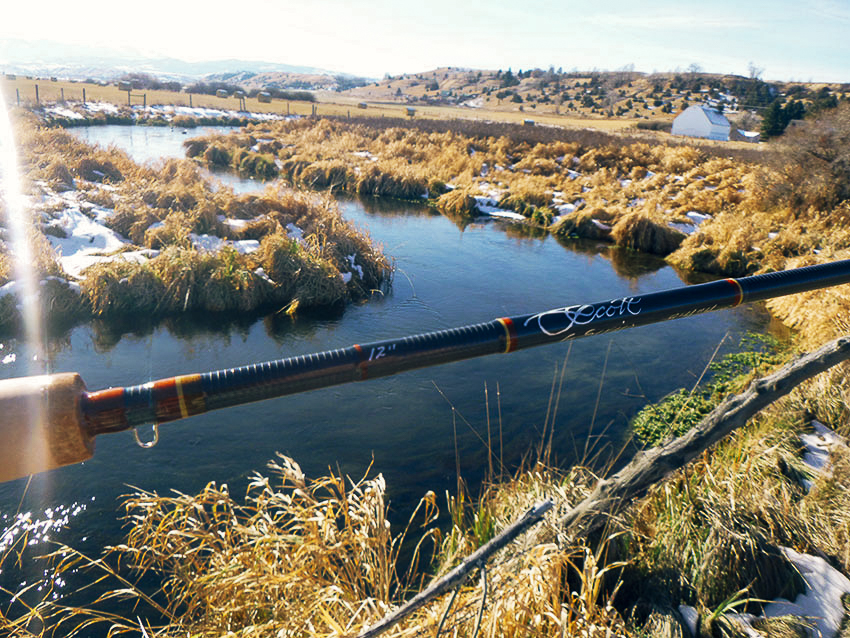

I really expected to see this new G Series 4-weight challenge the best rods. It is a very smooth rod to cast and was excellent at short and mid-distances, but at the longest distance the Radian, Helios 3F, and Avantt were much better. But this is a fairly soft rod, and didn’t have the butt power to handle the long distance quite as well as the more powerful rods. The swing weight was fairly light, but not quite as good as either the Hardy rods or the Orvis rods.
This is a very pleasant rod to cast, with a medium fast action. The Radian is both stiffer and faster in action. If you are a Scott fan and want a rod for fishing at short to medium distances, you’ll likely prefer this rod over the Radian.
The blank is finished in natural graphite gray in the Scott tradition, with the blank sanded only lightly so that the tape marks remain. Scott claims that this gives their rods better strength and we cannot argue with this as we see very few Scott rods broken.
This rod uses spigot ferrules, rather than the slipover ferrule design found on most rods including the Scott Radian. Scott feels that this gives the rod a smoother one-piece type action, and I agree as this is a very smooth casting rod that gives me a lot of feel at short to mid distances.
The cork handle is a more conventional western style grip than found on their Radian, with a flare on the back to accept the black anodized single uplocking seat that utilizes a brown graphite insert. The ring seems to lock up well. For guides, there is a hook keeper followed by a single SiC stripping guide, then hard chrome snake guides. The wraps are brown with some amber trim. The epoxy coatings are excellent as is the overall craftsmanship, which we have come to expect from Scott.
The perfect line: SA Amplitude Smooth Trout in WF-4-F
George’s casting notes:
Performance at 25 feet: 19.5 points out of 20
Very nice feel with excellent accuracy at short distances. Better than the Radian and Helios 3F in close.
Performance at 40 feet: 19.5 points out of 20
This is an exceptionally smooth casting rod, and I’m getting nice tight loops and very good accuracy. Only the Zephrus and Pure were better at mid-distance.
Performance at 60 feet: 8.5 points out of 10
Now the lack of butt power hurts, and I cannot throw the tighter loops or get the same kind of accuracy I was getting with the Radian, the Helios 3F or the T&T Avantt.
#8. (tie) Douglas DXF 8’6” #4 $349.00
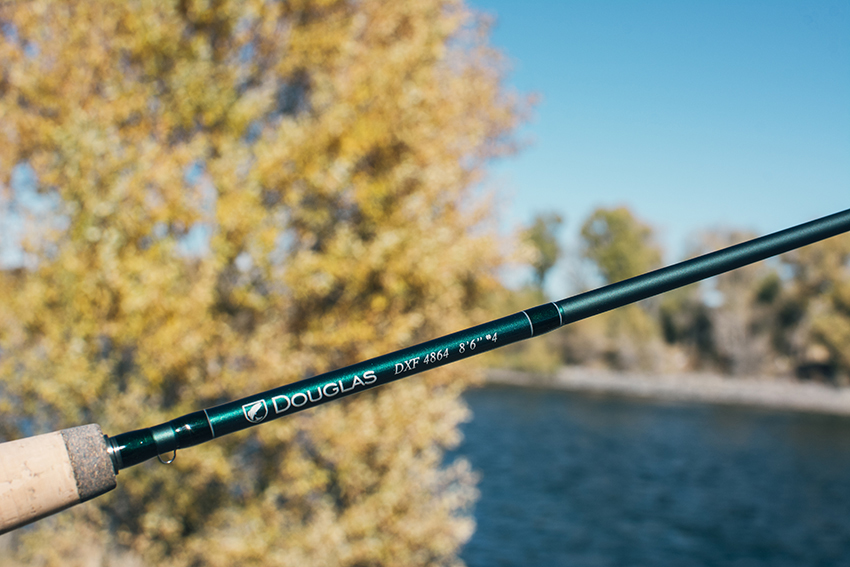

Here’s a mid-priced rod that put in a good performance across the board. In the 4, 5, and 6-weights, the DXF is a great casting rod.
One of the things that I liked was the light feel of this rod in my hand. The very light swing weight confirms this. The medium fast action seems just right and I’m getting both good feel and good accuracy at the shorter distances. The Douglas Sky was both heavier and stiffer, and didn’t perform as well, except out long at 60 feet.
The DXF has been one of our top mid-priced rods, but there was no denying the Hardy Shadow and Orvis Recon were better.
I love the appearance of the DXF, with the blank finished in a flat, non-glare dark green. The wraps are darker green and the epoxy coatings were nicely done. The handle is a half wells western style grip with contrasting dark composite cork rings at both the bottom and top. The quality of the standard size cork rings was very good. Douglas uses a dark green anodized double ring uplocking seat, with an attractive brown wood burl insert. For guides, there is a hook keeper just above the handle, and then one SiC stripping guide followed by hard chrome snake guides.
The perfect line: SA Amplitude Smooth Infinity in WF-4-F
George’s casting notes:
Performance at 25 feet: 19.0 points out of 20
Nice and light in hand with very good feel and accuracy in close. Better than the Sky but can’t match the Shadow.
Performance at 40 feet: 19.0 points out of 20
This is a very smooth rod to cast and I’m getting nice tight loops and good accuracy. Short to mid-range seem to be the best distances for the DXF.
Performance at 60 feet: 8.5 points out of 10
Here the lack of butt power hurts a bit but it was better than the Shadow out long and matched the Scott G-Series.
#10. Scott RADIAN 8’6” #4 $795.00
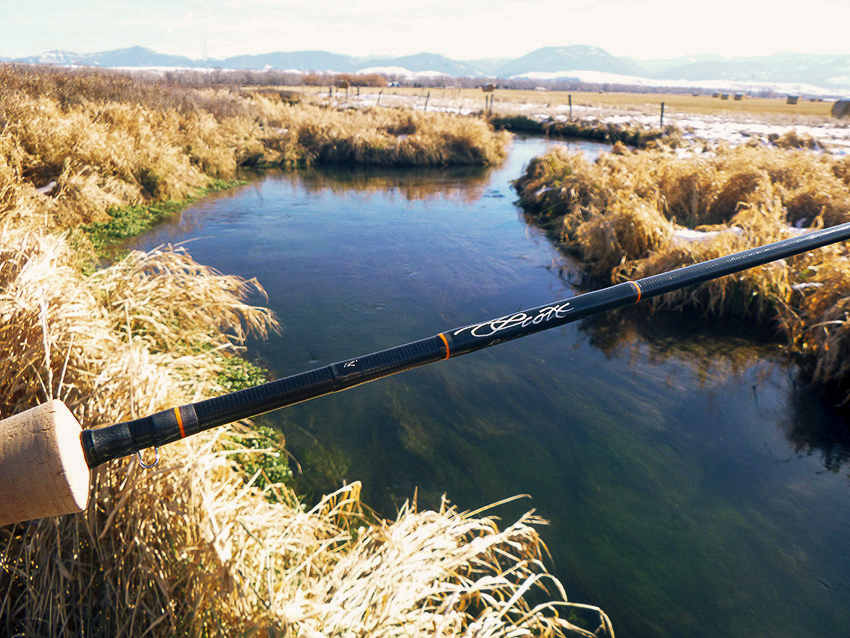

The Radian placed 2nd in our last 5-weight Shootout and I was surprised to see that it was this far down the list in a 4-weight. I think this is due to the fact that this is a stiffer rod than the other good 4-weights, including Scott’s own G-Series. The Radian has a faster action than the G Series, with more power in the butt and mid section that allow it to cast better at the longest distance. But this power and the stiffer tip hurt the performance in close, where it is similar to the Avantt but not nearly as good as the Zephrus, Pure or Helios 3F.
This is one fantastic looking rod – one of the very best in our Shootout. I was tempted to give it a perfect score for craftsmanship. One of the things I really like is the shape of the full wells cork handle. It has a pronounced swell that is slightly forward of the center of the grip – much different from the more standard western style grip of the G Series. Scott uses a stack of thinner cork rings on this handle and the quality was excellent.
The blank is graphite gray and follows Scott’s practice of sanding the blank only lightly and allowing the tape marks to remain. This rod uses the more conventional slip over ferrule design as on all but one of the other rods in our Shootout. The guide wraps are a slightly darker gray, trimmed in orange on the butt. I also liked the 12-inch mark on the butt but I wish they had also given us one at 18 or 20 inches. The quality of epoxy coatings on the guide wraps was excellent and almost the equal of the T&T rods.
The uplocking black anodized skeleton reel seat utilizes a single ring that is easy to grip and lock down. The fancy burl wood insert just jumps out at you with its striking color – lots of red and orange mixed in – very attractive. The guides start out with a hook keeper, then one SiC stripper followed with hard chrome snake guides that are nice and light on the tip sections.
The perfect line: SA Amplitude Smooth Infinity in WF-4-F
George’s casting notes:
Performance at 25 feet: 19.0 points out of 20
Heavier in hand than some of the best rods and I’m not getting as much feel or accuracy as the G Series. I think the stiffer tip hurt here.
Performance at 40 feet: 19.3 points out of 20
Better now, with more line in the air, but the G series was still a little better in both feel and accuracy. The top three rods were a lot better.
Performance at 60 feet: 9.5 points out of 10
Now the good butt power helps and I’m getting very nice loops, good control and excellent accuracy – equal to the Avantt and even better than the Zephrus.
#11. Fenwick AETOS 8’ #4 $179.95
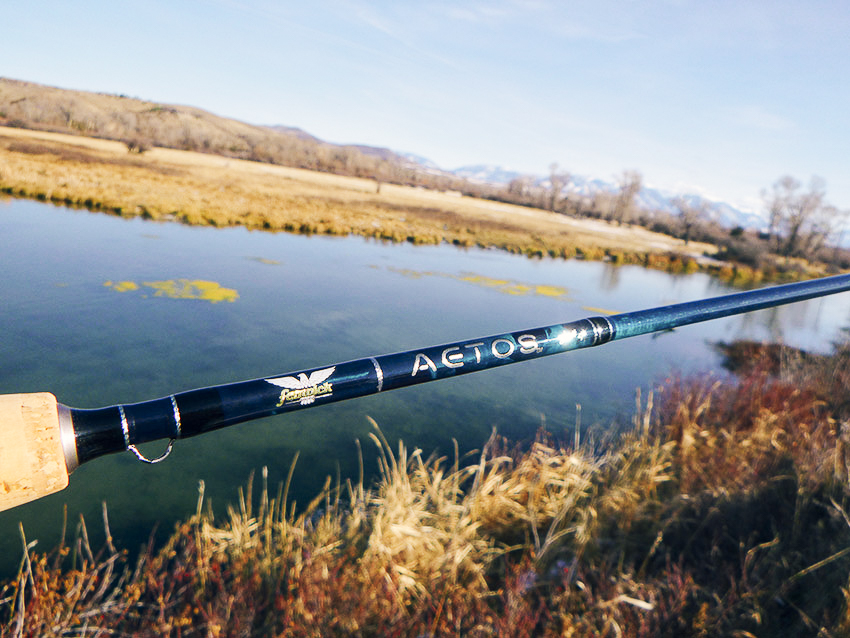

This rod is absolutely the winner for our “Best Buy” (best inexpensive) 4-weight Rod. Nothing else is even close.
What is a cheap rod like this doing up here with all the far higher priced rods, many of which cost $700 more? Certainly the Aetos wins points in the price category, but the biggest reason is its performance. If you look at the performance scores, you’ll see that the Aetos finished in 11th place here also.
I wish that we could have tested an 8’6” Aetos, but this rod is only available in an 8 foot #4. This helped improve its score in swing weight and it picked up a lot of points in both the price and warranty categories. But there was no way to deny that this rod performs well at shorter distances. A lot of this can be attributed to the nice action – good butt and mid section power combined with a lighter, softer tip, much like the Zephrus. The soft tip also earns it one of the best scores in light tippet protection.
Even though less expensive components are used, this is still a pretty nice looking rod, with the blank a rich deep blue with dark brown wraps that include a little silver trim on the butt section. The epoxy coatings on the wraps are a little heavy, but I’ve sure seen worse. The cork handle is a half wells design and the quality of the cork is not nearly as good as the best rods and a lot of filler is used. The double uplocking reel seat is plain anodized aluminum –dark gray with silver rings and not nearly as attractive as the better skeleton seats with good-looking wood inserts. Guides start with a hook keeper and then one SiC stripper, followed with fairly thin diameter black hard chrome snake guides. Some good alignment dots and lines are used.
The perfect line: SA Amplitude Smooth Infinity in WF-4-F
George’s casting notes:
Performance at 25 feet: 19.0 points out of 20
Nice and light in hand and the softer tip is giving me pretty good feel and accuracy, about as good as the DXF. The Shadow and Pure were far better.
Performance at 40 feet: 18.5 points out of 20
The action seems about right and I’m getting nice loops. The accuracy was good but not as good as the DXF or all of the best rods.
Performance at 60 feet: 7.5 points out of 10
Now the lack of butt power becomes evident and it is hard for me to get any decent accuracy.
#12. G. Loomis NRX LP 9’ #4 $745.00
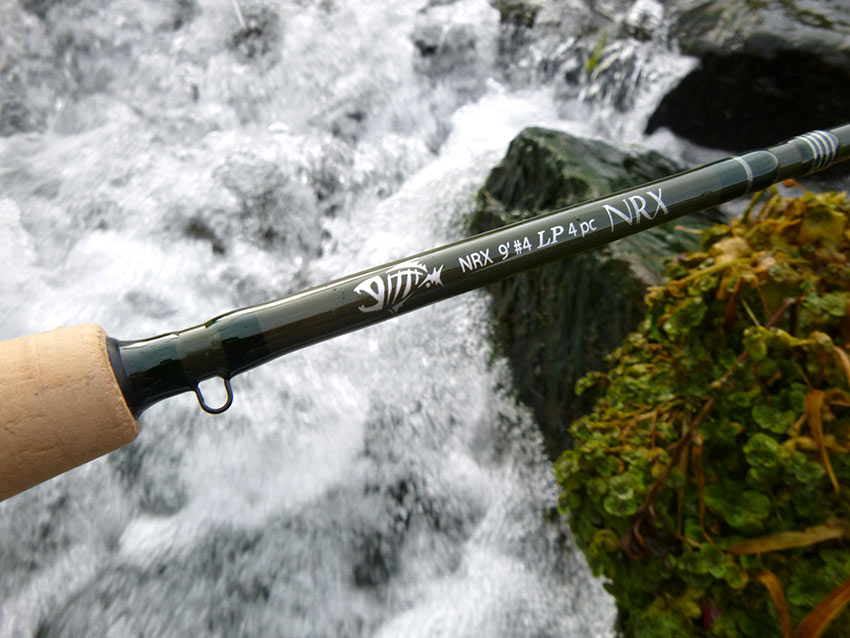

The NRX LP has proven to be an outstanding rod as a 5-weight, winning our 5-weight Shootout several times. I’m really surprised it is so far down in our finishing order as a 4-weight. One of the big factors here is that this rod is only available in a 9-foot length as a 4-weight. The added weight and relative stiffness over the other best rods hurt many of its scores. This is still a very good casting rod overall, but it just doesn’t come close to matching the scores turned in by the top rods in this Shootout.
The overall weight is good, but the swing weight is greater than all the other top ten rods. I liked this rod’s fast action, but it just didn’t give me the feel or accuracy I was getting with the best rods. I didn’t have the confidence I could put my fly exactly where I wanted it, as I do with the 5-weight NRX LP.
If you do a lot of nymph fishing, the extra length will help, and this rod has enough butt and mid-section power to also chuck some smaller streamers.
The craftsmanship on the LP is typical Loomis excellence. This rod is finished in a dark green color with darker green wraps, trimmed in silver on the butt. The epoxy coatings on the wraps were excellent. The cork handle is a half wells western style grip, with a contrasting darker composite cork at the bottom end, over the flare for the reel seat. The quality of the standard size cork rings was terrific. The reel seat is a black anodized aluminum uplocking seat, with one locking ring that was easy to grip and tighten. A dark green graphite insert is used that complements the color of the blank.
Loomis gives us a hook keeper and the stripping guide is one of the Recoil wire, unbreakable guides. The rest of the guides are their terrific nickel/titanium single foot guides that are light and flexible but will never break. These single foot guides are finished in a dark color to complement the blank.
The perfect line: SA Amplitude Smooth Infinity in WF-4-F
George’s casting notes:
Performance at 25 feet: 19.0 points out of 20
The heavy swing weight hurt, and I wasn’t getting the kind of feel or accuracy I got with the G Series Scott or the Orvis Helios 3F.
Performance at 40 feet: 19.0 points out of 20
I’m getting nice loops but the Scott rods were better. Both the Zephrus and Pure were far lighter in hand, and far better in performance at 40 feet.
Performance at 60 feet: 9.0 points out of 10
Good, just not great. Equal to the Orvis Recon, but head to head the Avantt and Helios 3F were far better.
#13. Douglas SKY 9’ #4 $695.00
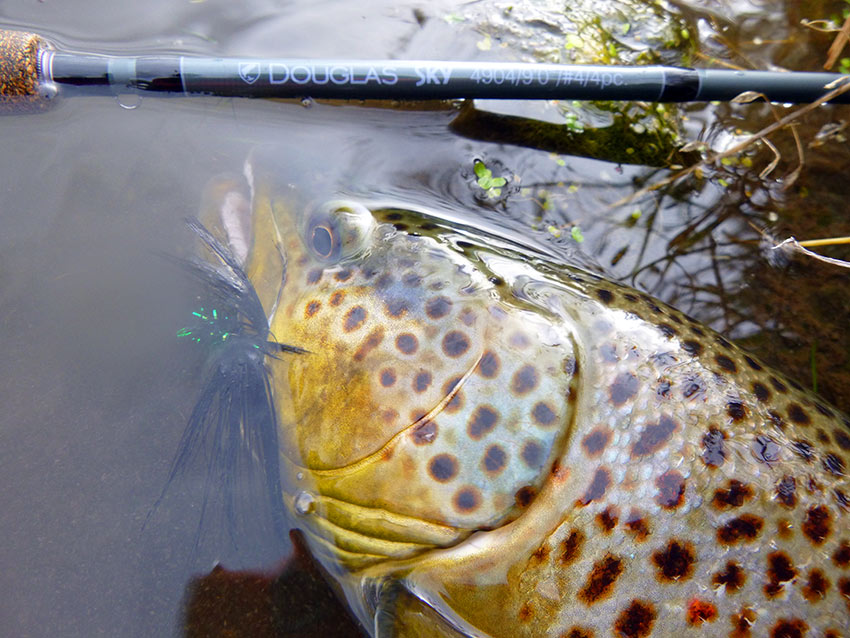

What gives? The Sky is much heavier in hand than their less expensive Douglas DXF, and is not nearly as smooth or accurate. One of the reasons is that the SKY is available only as a nine footer, while the DXF is 8’6”. The other reason is that this 9’ #4 SKY is just too stiff for a 4-weight. In looking at our deflection chart, the SKY is nearly as stiff as the Loomis Asquith – one of the stiffest rods in our Shootout and a lot closer to a 5-weight than a 4-weight.
In general the SKY rods do cast well, and the SKY 9 foot #6 won our last 6-weight Shootout. But the stiffness of this rod and its heavy swing weight hurt the performance scores, especially at the shorter distances.
I do like the fast action, just not the heavy swing weight, which is far heavier than the Douglas DXF. The heavy swing weight is perhaps the biggest reason the SKY didn’t perform so well.
There is a lot to like about the SKY though, and foremost is its appearance. This is a lovely rod, finished in a non-glare flat gray with jet-black wraps that are trimmed in light gray on the butt. The epoxy coatings over the wraps are very good but a little heavy in spots, as around the feet of the guides. The attractive cork handle is a half wells design with a flare on the bottom end, a comfortable swell in the middle, and a nice forward taper. The cork is excellent, and Douglas uses darker contrasting composite cork rings at both the top and bottom of the grip.
The double uplocking, gray anodized reel skeleton seat uses two rings that are easy to grip and lock up extremely well. A dark gray wood burl insert is used that matches the blank. Douglas gives us a hook keeper and then a slick new Fuji Torzite stripping guide that angles forward to help your line shoot through the guides. The rest of the guides are the excellent nickel/titanium one-foot guides in a silver color. In all, one of the best guide set ups we’ve seen. Lastly, the rod sock is superior, and will dry out quickly even if you put your rod away wet.
The perfect line: SA Amplitude Smooth Infinity in WF-4-F
George’s casting notes:
Performance at 25 feet: 18.5 points out of 20
The relatively heavy swing weight and stiffness are not giving me much feel, and the accuracy in close is not very good. The DXF and both Scott rods were better, while the Zephrus and Pure were in a totally different league.
Performance at 40 feet: 18.5 points out of 20
A little better here but the DXF still puts it to shame. Heads up, the Sage X and Recon were both better.
Performance at 60 feet: 9.0 points out of 10
Now the stiffness is becoming an advantage, and I’m getting some nice tight loops. Here it matches the NRX LP and the Recon. But the Avantt and Helios 3F are far better.
#14. (tie) Taylor TRUTH 9’#4 $649.00
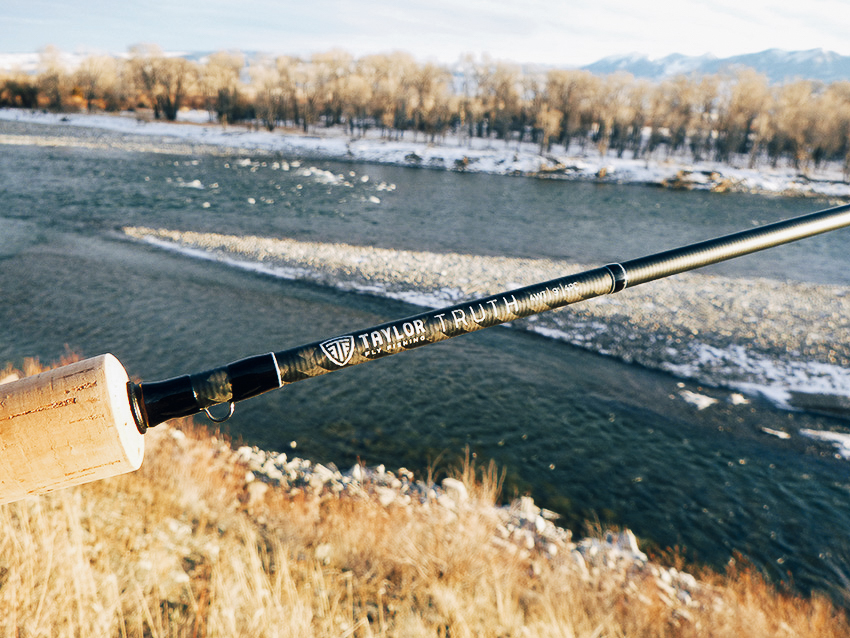

Here is a new rod that has not appeared in any of our previous Shootouts. Unfortunately like a few other rods, it is only available in a 9-foot model as a 4-weight, and this hurt its performance scores a bit. I like a lot of things about this rod. The craftsmanship was excellent and it performed very well for me, especially at 40 feet, where I was getting beautiful tight loops and very good accuracy.
This is a fast action rod. It’s perhaps a little heavy in swing weight, and this as well as its stiffness, hurt its score at 25 feet. As I put more line in the air, it tracked beautifully and was just a delightful rod to cast at 40 feet.
This is a good-looking rod, finished in a non-glare flat black. The wraps are also black, nicely trimmed in light gray on the butt sections. An attractive X-pattern graphite wrap is used behind the logo, just above the cork handle. The epoxy coatings over the wraps are nicely done, and I especially like the fact that they inscribe the rod length and weight on the bottom wrap of each section. This can be a huge help if you have multiple rods and the sections get mixed up.
The Cork handle is a full wells design that is slightly smaller where your thumb would rest, ahead of the swell in the middle of the handle. The black anodized double unlocking skeleton seat has two larger rings that are very easy to grip and tighten. A gray graphite insert is used that goes well with the blank. I’m impressed with the guide set up, starting with a hook keeper, then one SiC stripping guide, followed with the best nickel/titanium and flexible single-foot guides as on the Zephrus and Sky.
The perfect line: SA Amplitude Smooth Infinity in WF-4-F
George’s casting notes:
Performance at 25 feet: 18.5 points out of 20
The stiffness hurt, and it was hard for me to cast off the tip of the rod. I’m not getting much feel either.
Performance at 40 feet: 19.5 points out of 20
Forty feet was definitely the sweet spot for this rod. Now it tracks perfectly and I’m getting nice tight loops. Here it feels as good as the Scott rods and the Helios 3F.
Performance at 60 feet: 9.0 points out of 10
Nice and smooth. I’m able to form fairly tight loops, but the accuracy is not as good as what I’m getting with the Helios 3F or the Avantt.
#15.(tie) TFO FINESSE TROUT 7’9” #4 $229.95
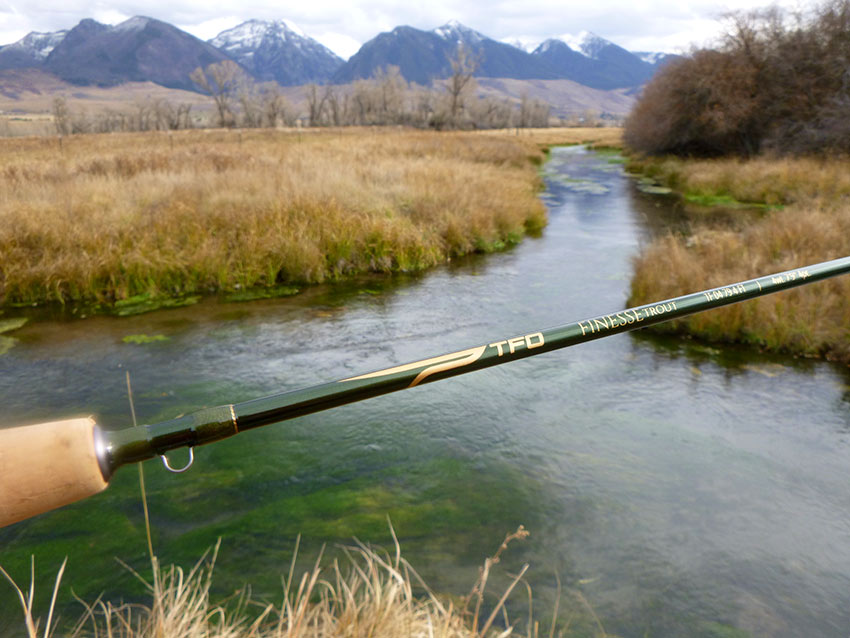

Of the two TFO Finesse rods, I like this 7’9” rod as a 4-weight a whole lot better than the longer 8’9” model. The shorter rod is nice and light, and faster in action than its longer brother. The action is medium fast – not as fast as the Pure but still feels very nice in my hand and produced some respectable performance scores. Since it is a lot shorter than my preferred 8 ½ foot #4, it ran up some high scores in both overall weight and swing weight. It is also a soft rod, so it scored very well in light tippet protection. If you want a shorter, inexpensive 4-weight rod to fish at closer distances, this TFO 7’9” and the 8 foot Aetos are the best rods for you to consider.
This rod is nice and light in hand, and performed well in close, where I was getting pretty good feel and decent accuracy. However at long range, it had no guts, and was one of the worst in our Shootout.
TFO uses an olive green blank for this rod, with olive wraps that are trimmed in gold on the butt sections. The epoxy coatings are fairly good, but a little heavy. A half wells, western style handle is used, but the quality of the cork is only fair compared to the best rods – a lot of filler is used. A single uplocking, gray anodized skeleton seat is fitted with an attractive burled wood insert. The locking ring is easy to grip, but I’d prefer a double ring seat as this one looks like it will loosen up more easily than most. The guides start with a hook keeper, and then one huge stripping guide that looks way too big, followed with thin wire hard chrome snake guides.
The perfect line: SA Amplitude Smooth Trout in WF-4-F
George’s casting notes:
Performance at 25 feet: 18.5 points out of 20
Nice and light in hand and pretty good feel, but the accuracy is not as good as I was getting with the Aetos.
Performance at 40 feet: 18.5 points out of 20
Matches the Aeteos here, but still nothing to get excited about. The DXF was better and the Shadow was far better.
Performance at 60 feet: 6.5 points out of 10
Long distance was hopeless. Just not enough butt power to get the job done. And if there was any wind, I couldn’t make good enough back cast loops to hit the distance.
#16.(tie) R.L. Winston NIMBUS 8’6” #4 $650.00
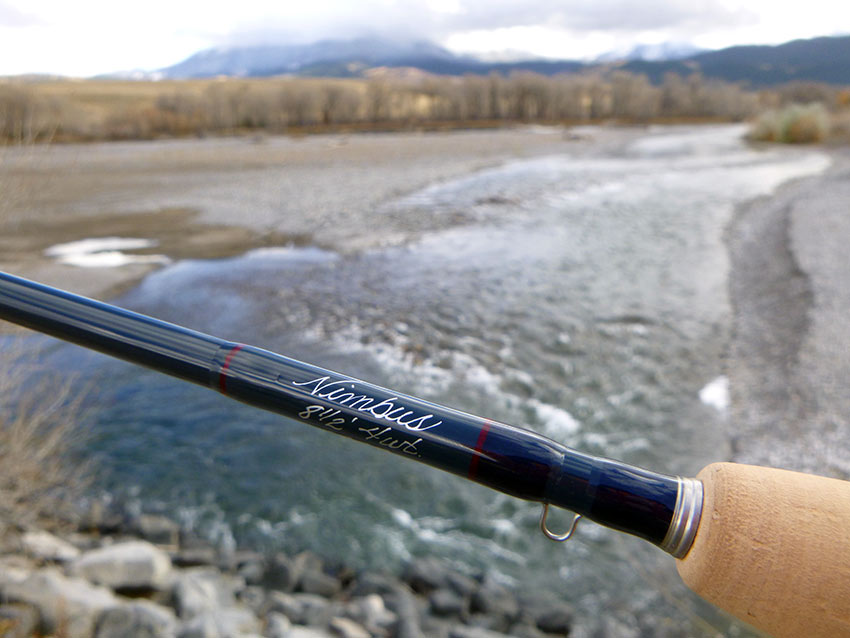

Although we thought that the Winston 8 foot Pure was a fantastic 4-weight, the Nimbus didn’t get us too excited. The big reason it didn’t do better than middle of the pack was the action. This is a soft rod, with a slower action than the Pure. The 8 foot Pure had a much stiffer butt and mid-section and a soft tip that is much softer than what we found on the Nimbus. Since the Nimbus was a softer rod, it did score well in light tippet protection, but in the most important Fun to Fish category, where the Pure got a perfect score, the Nimbus had one of the lower scores – about the same as the much less expensive Orvis Clearwater and St. Croix Imperial. The casting scores were only fair to good, and in my notes I say that I am getting very little feel or accuracy in close compared to the best rods.
At $650 I expected it to do better. The craftsmanship was very good, but not good enough to give it a perfect score like the Pure. The thing that killed this for me was the cheap looking reel seat. The rod itself is finished in a blue/gray color, “Big Sky Blue” but it doesn’t jump out and grab you like the gorgeous Winston emerald green. The wraps are dark blue to match the blank and the epoxy coatings are excellent. The cork handle is Winston’s cigar grip, like the Pure, with the center swell a little forward of the center of the grip and a flare on the bottom end. This is a comfortable grip and the quality of the cork is superb.
Rather than give us their beautiful nickel silver uplocking seat with a fancy wood spacer of birdseye maple as on the Pure, the Nimbus uses a silver anodized uplocking aluminum skeleton seat with one wide ring and sliding band. The spacer is not fancy burl or birdseye maple, but laminated wood as often seen on inexpensive rods.
For guides, there is a hook keeper, then a single SiC stripping guide, followed with hard chrome snake guides that are nice and thin on the tip sections. The serial number of the rod is inscribed on the ferrule of each section – a nice touch.
The perfect line: SA Amplitude Smooth Infinity in WF-4-F
George’s casting notes:
Performance at 25 feet: 18.5 points out of 20
A lot heavier in hand than the Pure, and the stiffer tip is not giving me much feel. The accuracy is only fair. A real let down after the terrific performance I was getting with the Pure.
Performance at 40 feet: 18.5 points out of 20
Nothing to write home about. Both the mid-price DXF and Imperial were better.
Performance at 60 feet: 8.0 points out of 10
Not very good at long range either. The softness didn’t allow me to make good hard backcasts in an effort to form tight loops.
#16.(tie) Thomas & Thomas ZONE 8’6” #4 $495.00
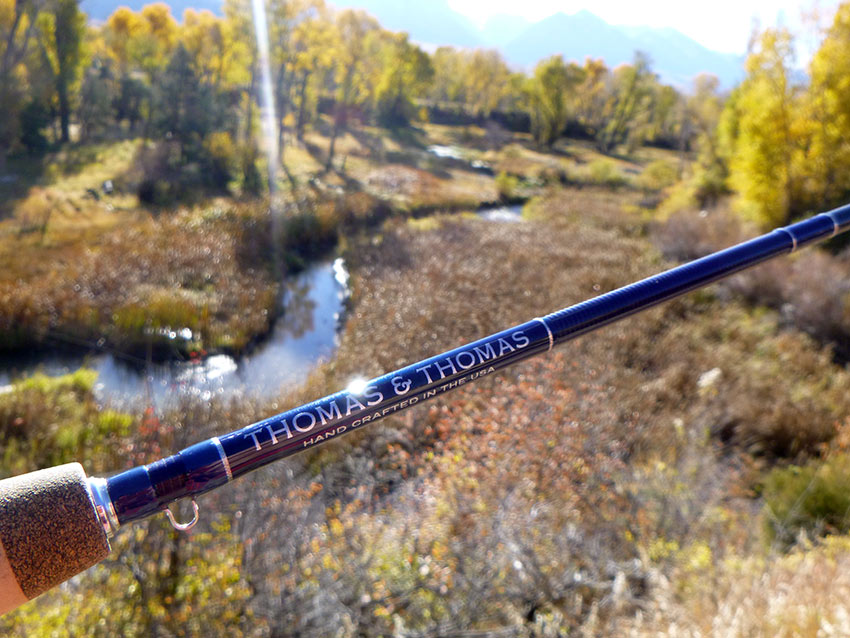

I loved the crisp, fast action of the Avantt and its light swing weight, but unfortunately the Zone is not nearly as nice. We like the lower price, and you can’t expect the same kind of performance as the $845 Avantt which uses a more expensive, higher modulus graphite.
This is T&T’s mid-priced rod, but if you take a look at the best mid-priced rods in our Shootout like the Shadow at $349, the Recon at $429 and the DXF at $349, the Zone’s performance doesn’t match any of these rods.
The action of the Zone is much slower than the Avantt (and also a lot slower than the Recon or Shadow). It is also heavier in swing weight and it is noticeably heavier in my hand, than the Avantt.
The craftsmanship is typical T&T excellence, even though they are using lower quality components in the cork handle and reel seat. The blank itself is unsanded natural graphite gray, much like the Scott rods, leaving the tape marks visible. The guide wraps are in blue with some silver trim on the butt. The lower 7 inches of the butt, including the logo is also finished in a dark blue. The handle is a western style grip, without much of a swell in the middle but a flare on the lower end to accommodate the uplocking reel seat. A contrasting dark composite cork ring is used at the top of the grip. The quality of cork is pretty good, but not in the same class as Avantt.
The uplocking skeleton reel seat is silver anodized aluminum, with one good-sized locking ring and sliding band, similar to the Avantt. But then rather than a beautiful piece of burled wood insert as on the Avant, there is a plain piece of blue colored graphite that also shows the tape marks.
The guides start with a hook keeper, and then one relatively small silver SiC stripping guide, followed with hard chrome single-foot guides. The wraps are all in blue, and the epoxy coatings are all extremely well done. Like the Avantt, each section is inscribed with the serial number of the rod so that you can avoid mixing up sections if you have similar rods.
The perfect line: SA Amplitude Smooth Infinity in WF-4-F
George’s casting notes:
Performance at 25 feet: 18.5 points out of 20
Much heavier in hand than the Avantt, and the stiffer tip is not giving me as much feel or accuracy.
Performance at 40 feet: 19.0 points out of 20
This was the best distance for me with the Zone. Here I’m getting nice loops and decent accuracy, but I’m working a lot harder than with the Avantt or the Helios 3F.
Performance at 60 feet: 8.5 points out of 10
The heavier swing weight makes casting at longer distances a workout. The accuracy suffers too. The Recon was much better.
#16.(tie) St. Croix IMPERIAL 8’6” #4 $270.00
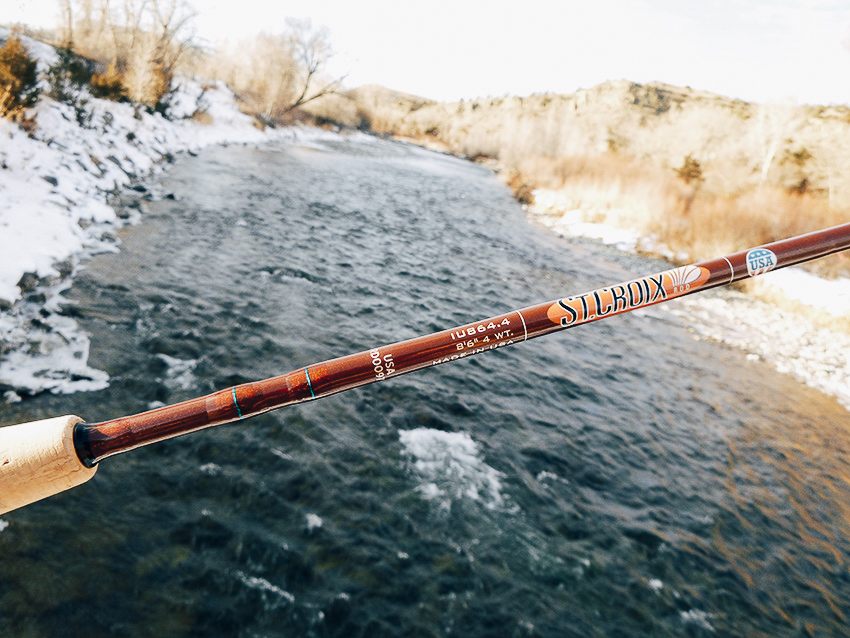

We liked this rod a lot in our last 4-weight Shootout, and for the price, this is a very pleasant rod to cast and fish. I like the action, which is medium fast. This rod has good power in the butt and mid sections and a softer tip, much like the action on some of our top rated rods.
It is refreshing to see such a nice rod, at such a low price that is made here in the US, in Park Falls, Wisconsin.
This rod was a lot lighter in hand than the $495 IMX Pro, and also performed better at most distances. It performed better than any of the sub $300 rods, including the Orvis Clearwater. The softer tip on the Imperial gave me good scores at the both 25 and 40 feet, and also led to a good score in light tippet protection.
The blank is a pleasing burgundy that sparkles in the sunlight. There are matching burgundy wraps on the guides, and the epoxy coatings were very well done. The cork handle is a western style grip with a comfortable swell in the middle and a nice taper forward. A flare on the bottom end of the grip accommodates the uplocking seat. The quality of the cork was surprisingly good for a less expensive rod. A black anodized double uplocking skeleton seat is used with an unusual x-pattern design and a laminated wood insert. The rings on the seat were fairly large and easy to tighten, giving a secure lock up.
The guide set up starts with a hook keeper, then one relatively small SiC stripper, followed with good sized black hard chrome snake guides that are nice thin diameter wire.
The perfect line: SA Amplitude Smooth Infinity in WF-4-F
George’s casting notes:
Performance at 25 feet: 18.8 points out of 20
Feels good in my hand, and I’m able to cast well off the tip. The softer tip is giving me a good amount of feel and the accuracy was better than the Zone or Nimbus.
Performance at 40 feet: 19.0 points out of 20
I’m getting nicely controlled loops and good presentations. Accuracy is pretty good, heads up matching the Zone and NRX LP.
Performance at 60 feet: 8.5 points out of 10
Out long the overall softness of the rod is a handicap. Equals the DXF but rods like the Recon and Sky were much better.
#19. (tie) Sage X 8’6” #4 $900.00
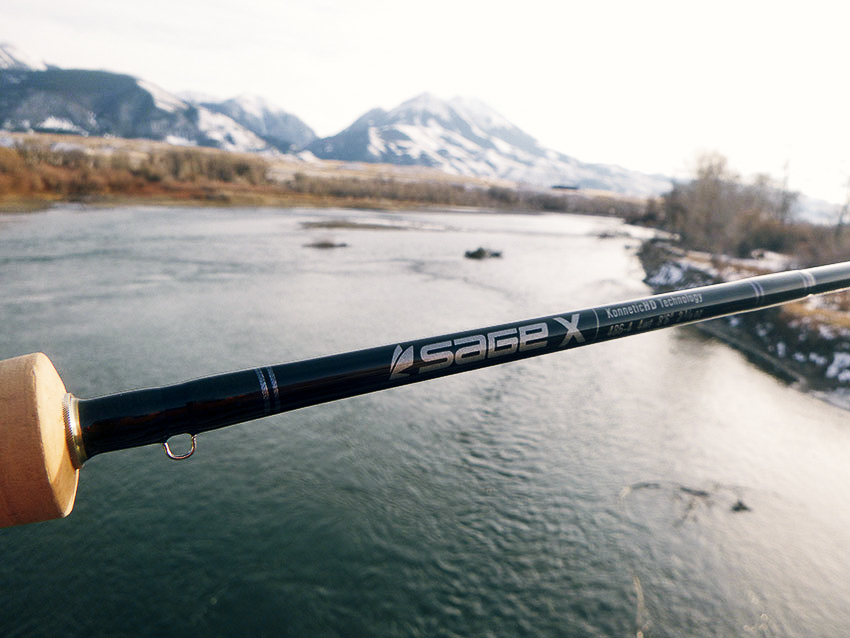

I’m surprised that both Sage rods are well down the list, but their performance scores were just not good enough to rate them higher. The Sage X is light in overall weight, but far heavier the most in swing weight. Rods that were very light in swing weight like the Zephrus, Avantt and Helios 3F blew the X away in both feel and performance.
The X is a medium fast action rod built with Sage’s KonneticHD technology that they say delivers greater blank recovery and good dampening. This rod has a stiffer tip than many of the best rods, and I felt this hurt both feel and accuracy at the two shorter distances.
The amount of power seems to be about right, and it performed best at the longer distances where I could punch it hard without throwing tailing loops. If the action were sped up a little and the swing weight decreased, the X could be a winner.
The X is an attractive rod with the same fine craftsmanship that we have come to expect from Sage. The blank color at first glance looks black, but is a very dark green called “Black Spruce.” The thread wraps are dark green, trimmed with metallic gray on the butt section. The epoxy coatings are good but too heavy for my liking. It was even a little sloppy on the tip sections. For this we downgraded the craftsmanship a half a point. We can attribute this to the use of one-coat finish rather than multiple coats as seen on the T&T rods.
The cork handle is what Sage calls a snub nose half-wells. There is not much swell in the middle of the grip and it tapers just slightly forward. It does feel very comfortable to me when I’m casting it. They use a stack of thin diameter cork rings and the quality of the cork was good.
The reel seat is a black anodized, single uplocking skeleton seat with a dark wood insert. They inscribe the sliding band with the line size, which is a nice touch. The guides are one hook keeper; a single SiC stripper and then all the rest are hard chrome snake guides that are durable but heavy. I wish they would had used the lighter, flexible nickel/titanium snake guides found on the Helios 3F, or even better, the nickel titanium single-foot guides found on the Hardy Zephrus, which would have improved its heavy swing weight.
The perfect line: SA Amplitude Smooth Infinity in WF-4-F
George’s casting notes:
Performance at 25 feet: 18.8 points out of 20
Heavy in hand! The stiff tip didn’t allow me much feel but the accuracy was decent. Head to head, the Radian and Avantt were better.
Performance at 40 feet: 19.0 points out of 20
With more line in the air I’m getting nice loops and good accuracy. Casting head to head, the Scott rods and the Helios 3F were both a lot better.
Performance at 60 feet: 9.0 points out of 10
Now I’m getting nice tight loops and I can punch it hard into the breeze. But the accuracy was still not as good as the best rods. Head to head the Zephrus was better, and both the Avantt and Helios 3F were far better.
#19. (tie) Loop OPTI K2 9’ #4 $549.00
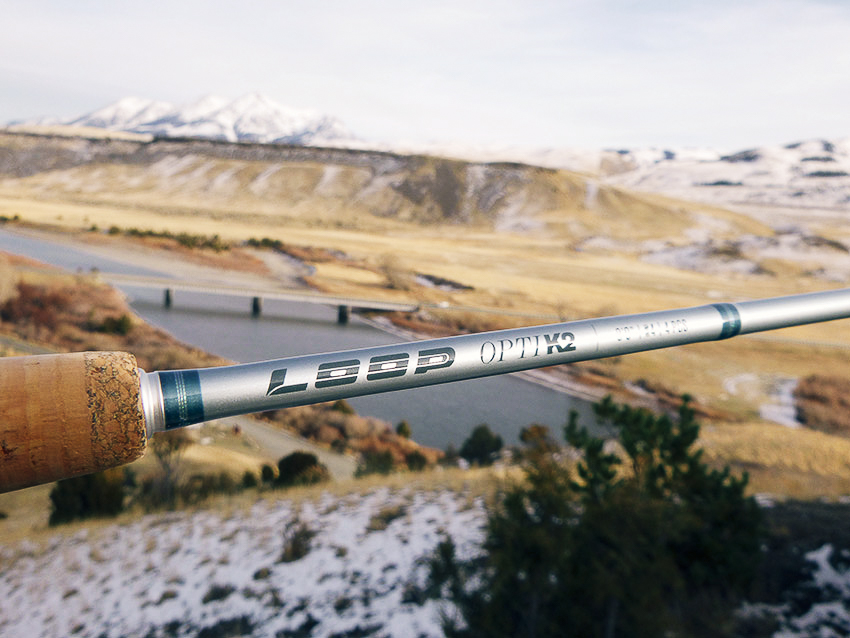

Here is a brand new rod from Loop that we liked better than their stiffer, more expensive Cross rods. I liked the medium fast action, and this was a pleasantly smooth rod to cast, especially at the longer distances. It was a little heavier than the best rods in both overall weight and swing weight but part of this can be attributed to it being a 9 foot rod, while most other rods in our 4-weight Shootout are 6 inches to a foot shorter.
Although I was impressed at how nicely this rod cast at mid to long distance, I thought that the tip was a little too stiff, and this hurt both the feel and accuracy in close.
The K2 falls into the upper end of the mid-price range but it was blown away by the less expensive Hardy Shadow and Orvis Recon at 25 and 40 feet. Those rods are both a lot lighter in swing weight and faster in action. Out long the K2 seemed to hold its own with the Recon, and it was better than either the Shadow or DXF.
These rods are designed in Sweden, but built in Korea in the same factory that produces the fine Hardy rods. The craftsmanship of the K2 was very good. The color of the blank is a very light silver blue, with the guides wrapped in a darker grayish blue, with some silver trim on the butt section. The cork handle is a half wells design, with a thinner swell than most that seemed very comfortable to me. It is trimmed top and bottom with contrasting, composite cork rings. The quality of the standard size cork rings was excellent.
The reel seat is an unusual, triangular shaped silver anodized seat with no spacer. It has a sliding band and single locking ring that seems to lock up well enough but squeaks a little as you tighten it.
There is no hook keeper on this rod. The guides start with a single SiC stripping guide followed with fairly large diameter but thin wire hard chrome snake guides. The epoxy coatings were a bit too heavy though, not nearly as nice as what we see on the Hardy rods.
The perfect line: SA Amplitude Smooth Infinity in WF-4-F
George’s casting notes:
Performance at 25 feet: 18.0 points out of 20
The stiffer tip didn’t allow for much feel or accuracy. Heads up the Recon and Shadow were far better.
Performance at 40 feet: 18.5 points out of 20
Nice and smooth but noticeably heavier in swing weight than the Recon and Shadow and not nearly as accurate.
Performance at 60 feet: 8.8 points out of 10
I liked the nice loops I was getting and the accuracy was also pretty good, but could not match the Recon or the NRX LP.
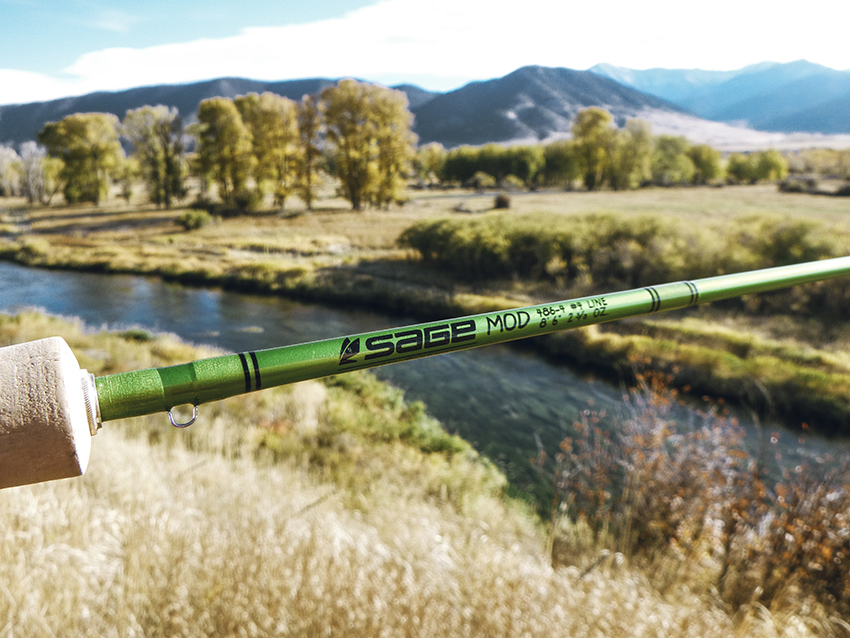

I loved the look of the Mod, with its standout, jazzy lime green color. But that was about all I liked, other than the very light overall weight that earned it a perfect score. Sage promotes the MOD as a rod that will deliver delicate presentations with pinpoint accuracy. I did not find that to be the case. This is a soft rod, and that gave it good marks in the light tippet protection category, but its performance distance scores were lackluster.
I just didn’t care for the moderate action that was a lot slower than the X. Although the overall weight was an amazingly light 2.3 oz, the swing weight was a fairly heavy 8.0 oz – about equal to the Scott G series.
This was one of the rods that we felt needed the lighter Trout line. But even with the lighter line, the accuracy was not very good. I was getting far better presentations and accuracy with both the Hardy Zephrus and Winston Pure.
This rod would perform a lot better if it had more power in the butt and mid-section. If you look at the deflection charts you will see how soft the butt and mid of the Mod are compared to the best performing rods. It also has a relatively stiff tip when compared to the winners.
Sage uses lime green wraps that complement the color of the rod. The epoxy coatings on the wraps were not so good – too heavy and about like what we saw on the X. The cork handle is that same snub nose, half wells found on the X and feels very comfortable to me. A stack of thin diameter corks is used and the quality is good. A black anodized uplocking skeleton seat is used with one ring and sliding band. The locking ring was harder for me to grip than most. A nice piece of dark hardwood is used for the spacer. Guides start with a hook keeper, then one SiC stripping guide followed with hard chrome snake guides. Sage could improve the MOD’s swing weight by using the more expensive nickel/titanium guides instead.
The perfect line: SA Amplitude Smooth Trout in WF-4-F
George’s casting notes:
Performance at 25 feet: 18.5 points out of 20
The soft, slow action produces a delivery I noted as “mushy”. It is nearly impossible to cast off the tip of the rod like I can with the best 4-weights.
Performance at 40 feet: 18.5 points out of 20
I just can’t push it at all and have to slow down my casting stroke to get any decent accuracy. The feel I’m getting is not that good either.
Performance at 60 feet: 7.0 points out of 10
Even with the lighter Trout line, it is hard to maintain good loops and get any kind of decent accuracy. With any breeze at all, I’m dead. This is one of the worst scores at long distance in our Shootout.
#22. Orvis CLEARWATER 8’6” #4 $198.00
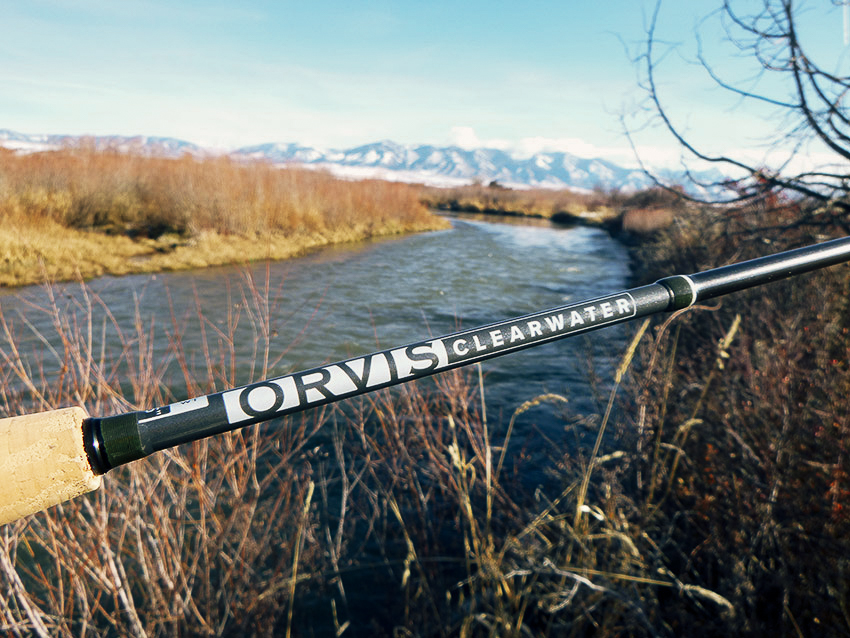

The best thing I found about the Clearwater is the price. That gives it a perfect score of 10 along with the Aetos. However, the 8-foot Aetos turned in much higher scores in several categories, including performance at 25 feet, swing weight and light tippet protection. The Clearwater is heavy in overall weight and very heavy in swing weight, making it a chore to cast. It is also a stiff rod – almost as stiff as the SKY and IMX Pro. Its medium action is far slower than the Recon or their H3F, and it didn’t perform nearly as well, especially at 25 feet.
Stiff, slower action rods are NOT what you are looking for in a 4-weight, where accurate, delicate presentations are the keys to success.
Overall, the craftsmanship was decent for a rod that is manufactured in Asia, but not nearly as good as what we see in the Recon and H3F that are built in Vermont. But superior craftsmanship commands a much higher price!
The Clearwater is finished in a dark gray color with dark olive guide wraps. The epoxy coatings over the wraps were surprisingly good for a one-coat finish. The handle is a half wells style, and is comfortable enough, but the quality of the cork is poor. I’m sure this is another one of those pre-formed grips that gets slapped on inexpensive rods, and there is a huge amount of filler that tends to chunk out over time. At least it is sanded to a smooth finish initially. The single uplocking reel seat is plain anodized gray aluminum with no insert. A sliding band and wide locking ring is used that is easy to grip and seemed to lock up well.
For some reason they don’t use a hook keeper on this rod, maybe another way to cut the cost? I’d gladly pay another few dollars to have one. For guides, they use one SiC stripping guide followed with hard chrome snake guides that are thin and light on the tip sections. Alignment dots are placed at the ferrules, which is handy.
The perfect line: SA Amplitude Smooth Infinity in WF-4-F
George’s casting notes:
Performance at 25 feet: 18.0 points out of 20
Not much feel with all that swing weight, and the accuracy was pretty crappy too. The Aetos was dramatically better for an inexpensive rod.
Performance at 40 feet: 19.0 points out of 20
Good, just not great. About as good as the Imperial, but the Recon and Shadow were noticeably better.
Performance at 60 feet: 9.0 points out of 10
The stiffness is a bonus at long range. It tracked well and the accuracy was good – better than the Imperial at long range.
#23. G. Loomis ASQUITH 9’ #4 $1000.00
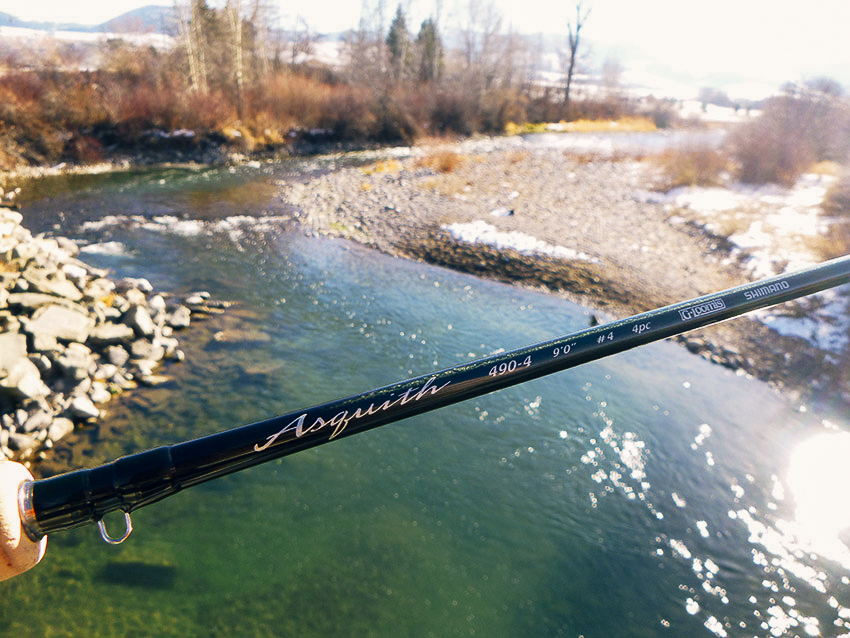

What is the Asquith doing way down near the bottom of this Shootout when it won our recent 8-weight Shootout!? It’s somewhat embarrassing for a $1000 rod to finish below one that costs only $198.00, but there are some good reasons for this.
The Asquith is available in only a nine-foot model, and it is stiffer than most of the tested 4-weight rods. This hurt somewhat in its scores for swing weight and light tippet protection. It also lost a huge number of points in the price and warranty categories that it couldn’t pick up in the casting distance performance categories. However, as you’ll see in the Performance Only scores, it finished much higher – in 12th place.
We have found that the Asquith rods are terrific rods in the heavier line sizes – from 6-weight right up through 12-weight. The 8-weight Asquith won our recent 2018, 8-weight Shootout, putting in a marvelous performance.
The 4-weight Asquith was one of the stiffer rods in our Shootout and this hurt its scores at the shortest distance of 25 feet. It was very light in swing weight, and quite accurate in close, but it just didn’t have much feel in close like the best rods. Out at long range it performed extremely well and was one of the very best, pretty much being equal to the Helios 3F and Avantt.
Steve Rajeff, the head rod designer at Loomis, designed the Asquith tapers, and the blanks are built by Shimano in Japan, using their unique “X wrap” process. The finished blanks are then shipped back to G. Loomis, where the rods are assembled, wrapped and finished at the G. Loomis factory in Woodland Washington.
To appreciate this rod, you need to see it in the sunlight. Then the dark green finish just sparkles. The craftsmanship is second to none and it earns a perfect score along with the Winston Pure and T&T Avantt.
The guide wraps are a dark green to complement the rod. The epoxy coatings are painstakingly done and close to perfect. The cork handle is a Steve Rajeff design; a half wells but with the swell slightly larger towards the front of the grip, and smaller back where the heel of your hand rests. This makes for a very comfortable grip that improves casting at longer distances. The cork is a stack of thin rings, and the quality of the cork is excellent. The reel seat is a gray anodized skeleton seat with a band and large single ring that is easy to grip and tighten securely. The insert is a gorgeous piece of bamboo, sourced from the same company that uses it for Lexus steering wheels. Guides start with a hook keeper, then a single titanium SiC stripping guide, followed with our favorite nickel/titanium snake guides that are flexible but unbreakable.
The perfect line: SA Amplitude Smooth Infinity in WF-4-F
George’s casting notes:
Performance at 25 feet: 18.5 points out of 20
The stiffness did not allow much feel but the accuracy was surprisingly good. Another stiff rod, the Avantt, was slightly better.
Performance at 40 feet: 19.2 points out of 20
The Asquith tracks beautifully and is giving me nice accurate tight loops. It was a little better than the Avantt here, but not as good as the H3F.
Performance at 60 feet: 9.5 points out of 10
Now we’re talking! At long range no rod has more power. The H3F rated slightly higher over all, but the Asquith had a lot more butt and mid-section power to blast out long casts. It would also one of the best 4-weight rods for throwing streamers.
#24. Mystic Reaper X 8’6” #4 $299.00
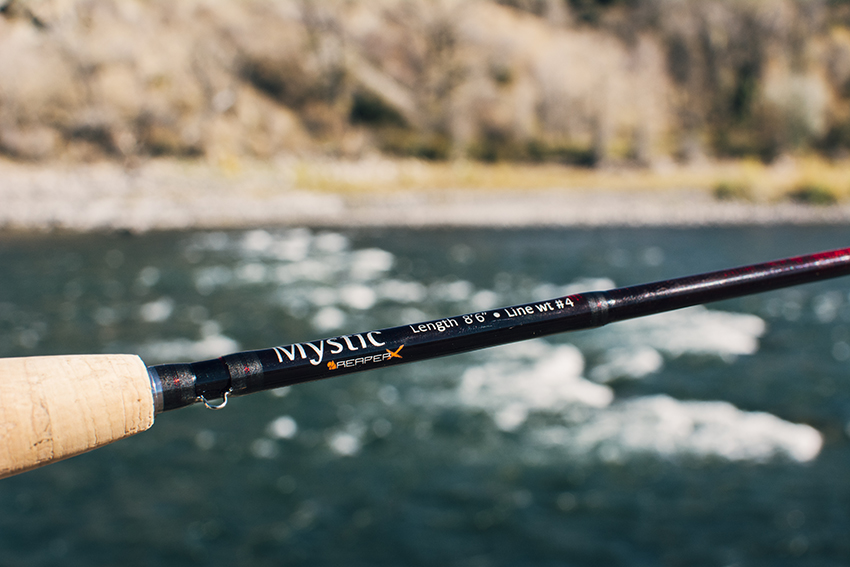

We have liked the Mystic Reaper that has done well in some of our early 5-weight Shootouts. The Reaper X is an improved model of this original rod. The new X has a nice medium fast action that delivers the best performance at short to medium distances. At one point it was our “Best inexpensive rod” until the Fenwick Aetos muscled it aside.
The softer tip on this rod gave me good feel and decent accuracy at close range and the amount of butt and mid-section power seems about right for a 4-weight rod. Swing weight is on the heavier side and this hurt the performance to some degree.
The one thing that I have never liked much on the Reaper is the shape of the handle. It has a larger swell than most rods, and the swell is set closer to the top of the grip, than most rods – well forward of the center of the grip. The quality of the cork is not too good either and it used a lot of filler.
The blank itself is a deep burgundy color, with dark gray wraps. Epoxy coatings on the wraps were a bit too heavy, adding unnecessary weight. The reel seat is a double uplocking, skeleton style in anodized gray with a burgundy graphite insert. The two locking rings are large and easy to grip and tighten. Guides start with a hook keeper, then two SiC stripping guides followed with fairly large diameter hard chrome snake guides.
The perfect line: SA Amplitude Smooth Infinity in WF-4-F
George’s casting notes:
Performance at 25 feet: 18.5 points out of 20
I was getting decent feel in close but accuracy was not that great. The DXF was significantly better.
Performance at 40 feet: 18.5 points out of 20
Pretty good loop control but the feel and accuracy were not as good as what I was getting with the DXF or the St. Croix Imperial.
Performance at 60 feet: 7.5 points out of 10
The lack of butt power made it difficult for me to get the delivery or accuracy I was getting with the Zone or DXF. The JXP was also better.
#25. G. Loomis IMX PRO 8’6” #4 $495.00
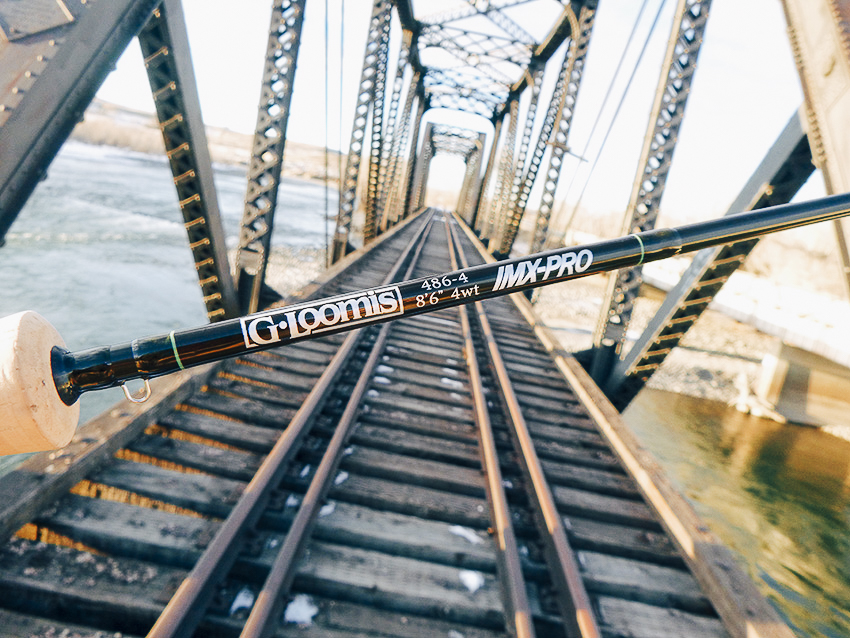

The IMX Pro is one of Loomis’ newest rods and we have liked it in the larger line sizes, like their 5 and 6 weight rods. This 8’6”#4, however, is just too heavy and too stiff to perform well as a 4-weight. Loomis designed these IMX Pro rods to be tough and very durable, and pro guides love them because they are so hard for clients to break. But this also means they have a heavy swing weight. When I put this rod in my hand it feels more like a 5-weight than a 4-weight! And a look at the deflection chart confirms this.
This rod has a slower action than the fast action NRX LP, as well as a stiffer tip. The stiffness and slower action hurt its scores in a lot of categories. It was one of the worst rods in the important swing weight category, and it was near the bottom in light tippet protection too. In the performance distance categories it was better at 60 feet than at the closer distances, but the overall weight and swing weight made it a workout to cast.
This is an attractive rod, with very good craftsmanship. The blank is finished in a dark olive green with dark green wraps, that include a little light green trim on the butt. The epoxy coatings on the guides were excellent. The handle is a comfortable full wells design, and the quality of the cork was very good. A darker composite cork ring is used on the bottom of the grip that is flared out to accept the uplocking seat. The skeleton reel seat is a gray anodized double uplocking with a dark gray laminated wood insert. I found the locking rings easy to grip and tighten.
The guides start with a hook keeper on the butt, then a single SiC stripping guide, followed with hard chrome single foot guides that seem sturdy enough, but are not nearly as good (or as light) as the nickel/titanium single foot guides used on the NRX LP.
The perfect line: SA Amplitude Smooth Infinity in WF-4-F
George’s casting notes:
Performance at 25 feet: 17.5 points out of 20
The stiff tip and heavy swing weight both contributed to a lack of feel and accuracy in close.
Performance at 40 feet: 18.0 points out of 20
Better as I get more line in the air, but still not nearly as good as the NRX LP or the DXF.
Performance at 60 feet: 8.5 points out of 10
Now the stiffness helps, and I’m getting nice loop control and decent accuracy.
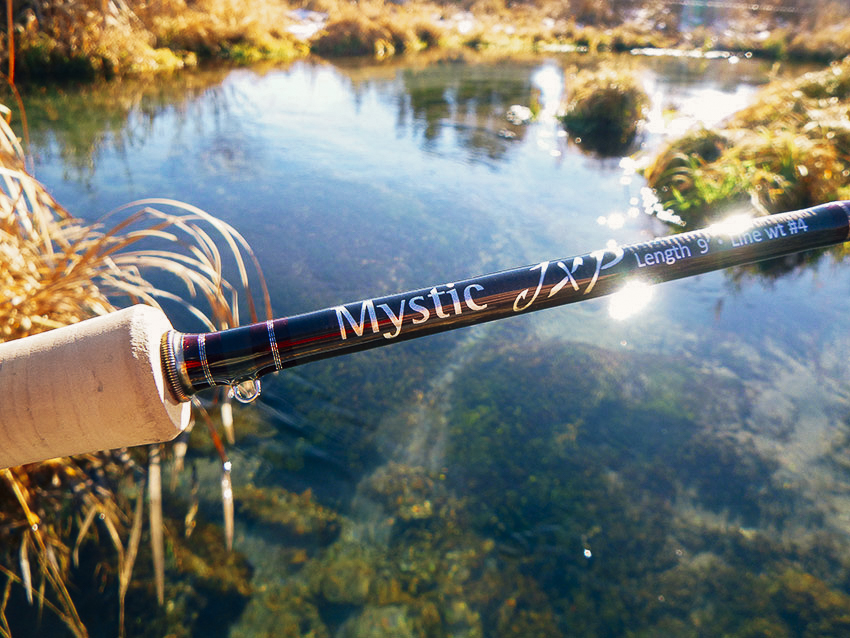

We like the looks of this new Mystic rod and the craftsmanship is better than we found on the Reaper X, but the price is a lot higher also. When I first picked the rod up, the overall weight was good but then when I wiggled the rod in my hand, I could see that the swing weight was heavier than almost all of the other 4-weight rods. In fact the JXP had one of the heaviest swing weights in our Shootout, tied with the IMX Pro and Clearwater.
Like many of the other 9-foot rods in our Shootout, it was at a disadvantage in weight to the shorter 8 and 8 ½ foot rods. The JXP is also very stiff. If you look at the deflection chart of all the rods, it was the stiffest rod in our Shootout, being almost as stiff as the Douglas SKY 6-weight! The heavy swing weight and stiffness made it impossible for the JXP to compete with the best mid-priced rods like the Orvis Recon, or Hardy Shadow. If you buy this rod, you need to put a WF-5-F line on it. Then it will cast and perform much better. This rod has a medium fast action with tons of power in the butt and mid-section, which allowed it to perform pretty well at the longest distance.
The color of the blank is a natural graphite gray, and only lightly sanded so you can still see the tape marks, much like the Scott rods. The wraps are done in a dark brown with some silver trim on the butt section as well as in the center of each guide foot wrap, that look nice. The epoxy coatings on the guides were good for the most part but a little too heavy on some guides.
I liked the full wells cork handle better than the odd grip on the Reaper X. The quality of the cork was much better too, but still not in the class of what we found on the Recon or Shadow. The single uplocking seat is gray anodized aluminum, and doesn’t use a spacer, but does have some trick looking cutouts on each side. The wide single ring was easy to grip and tighten.
Guides start with a hook keeper on the butt, and then two SiC stripping guides, followed with hard chrome snake guides that are large in diameter but thankfully use smaller diameter wire. An oversize tip-top is fitted to match the large guides.
The perfect line: SA Amplitude MPX WF-5-F. (However we tested the rod with the WF-4-F Infinity.)
George’s casting notes:
Performance at 25 feet: 18.0 points out of 20
It was hard for me to get any feel or accuracy with such a stiff rod and a light line. I could really notice the heavy swing weight in my hand.
Performance at 40 feet: 18.0 points out of 20
Still not so good with very little feel or accuracy. It would be so much better with a WF-5-F. Equal to the IMX Pro but that’s about it. The DXF and Imperial were much better.
Performance at 60 feet: 8.5 points out of 10
Better at the longest distances, much like the stiff IMX Pro. Now I’m getting a respectable performance that matches the Zone and DXF.
#27. TFO FINESSE TROUT 8’9” #4 $229.95
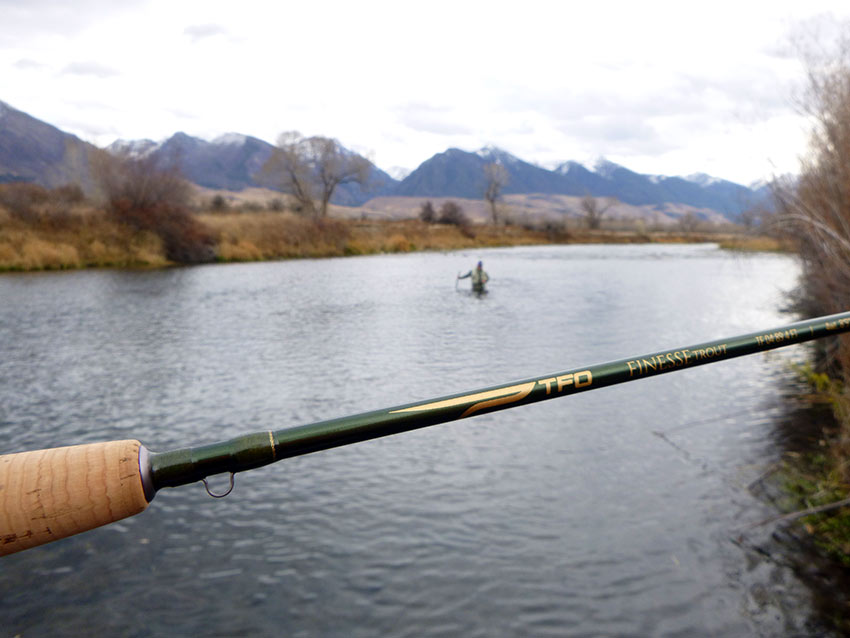

We should have probably dropped this longer Finesse from our Shootout as the shorter 7’9” Finesse performed so much better. The action of these two rods is very different. The 7’9” rod has a nice medium fast action, while this 8’ 9” model is far slower – much more of a medium action rod. It also has one of the heaviest swing weights in our Shootout. Only the Loop Q was worse. Slower action rods with a heavy swing weight are not much fun to cast and as you’ll see the performance figures for this rod are dismal. It also sits dead last in our Fun to Fish category. The 7’9” model was far better and a lot more fun to cast and fish.
The cosmetics and components of this rod are similar to its shorter brother. The blank is olive green with matching olive wraps that are trimmed in gold on the two lower sections. The epoxy coatings on the guides are pretty good but a little heavy in spots. A half wells handle is used and the quality of the cork is only fair to good compared to the best rods. The reel seat is a single uplocking skeleton seat in anodized gray that has a very attractive burled wood insert. The locking ring was fairly large and easy to grip and tighten but didn’t have a plastic ring like some that allow them to lock up more securely.
The guides start with a hook keeper, and then one huge SiC stripping guide that seems way too big, followed with hard chrome snake guides.
The perfect line: SA Amplitude Smooth Infinity in WF-4-F
George’s casting notes:
Performance at 25 feet: 16.5 points out of 20
For sure, one of the worst in our Shootout. Very little feel or accuracy. The 7’9” TFO Finesse was far better.
Performance at 40 feet: 18.0 points out of 20
I can sure notice the heavy swing weight and this is not a very pleasant rod to cast. Both feel and accuracy are poor.
Performance at 60 feet: 7.0 points out of 10
Tough for me to hit the longest distance, and if there was any breeze I couldn’t hit within ten feet of where I need the fly to go!
#28.(tie) Loop Q 9’ #4 $229.00
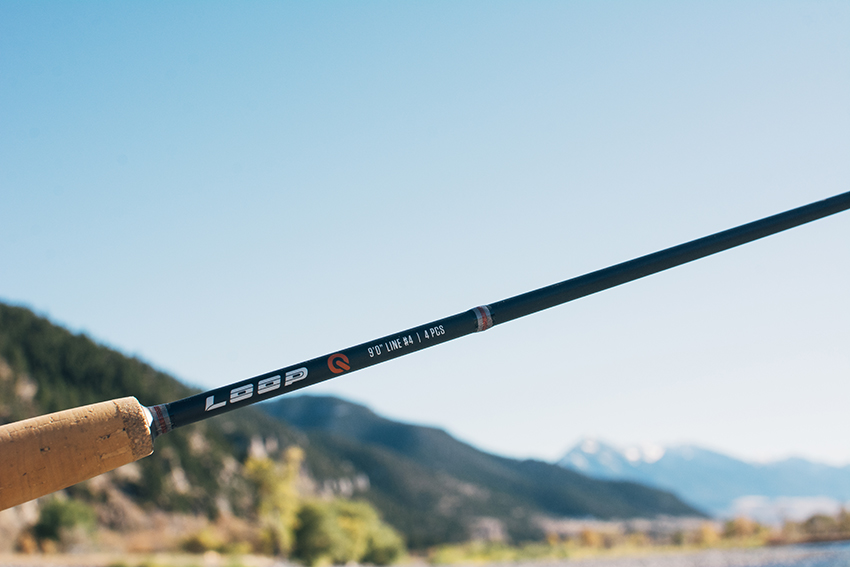

The Q was not nearly as good as their new Opti K2. The action is much slower, this being more of a medium action rod. It is also a lot heavier in overall weight and swing weight, mainly due to the fact that Loop is using a much lower modulus graphite than in their more expensive K2. Heavy, slower action rods never perform well. This 4-weight Q was one of my least favorite rods to cast in our Shootout. In our 2018, 8-weight Shootout the Q finished in the middle of the pack, but the 8-weight had a swing weight that was pretty good, while here as a 4-weight, the swing weight was one of the worst.
Like the K2, the Q is only available as a 9-foot rod in a 4-weight. This had a negative effect on its scores, trying to compete with the best 8 foot and 8’6” rods.
I did like the flat, non-glare black finish used on the blank. The guide wraps are gray, trimmed with red on the butt section and first ferrule. The epoxy coatings over the wraps were a little heavy, but I’ve seen worse. The length and model on each rod section is inscribed as on the K2. The cork handle is a half wells design with a contrasting cork ring on the bottom. The quality of the cork is not so hot though, and a lot of filler is present. The gray uplocking reel seat is solid anodized aluminum with a sliding band and two locking rings that were easy to grip and tighten. The lower ring uses a thin nylon spacer that helps it lock up securely to the upper ring.
Like the K2, no hook keeper is used, which I miss on a 4-weight. The guides start with one SiC stripping guide followed with very large diameter hard chrome snake guides.
The perfect line: SA Amplitude Smooth Infinity in WF-4-F
George’s casting notes:
Performance at 25 feet: 17.5 points out of 20
The heavy swing weight and stiffer tip gave me very little feel. The accuracy was not good either.
Performance at 40 feet: 18.5 points out of 20
Much better at our middle distance, and here it is as good as the K2 and Douglas SKY.
Performance at 60 feet: 8.0 points out of 10
This rod wore me out casting long. It had the power to hit 60 feet easily enough but my accuracy was not very good.
#28.(tie) Waterworks-Lamson SS 9’ #4 $399.99
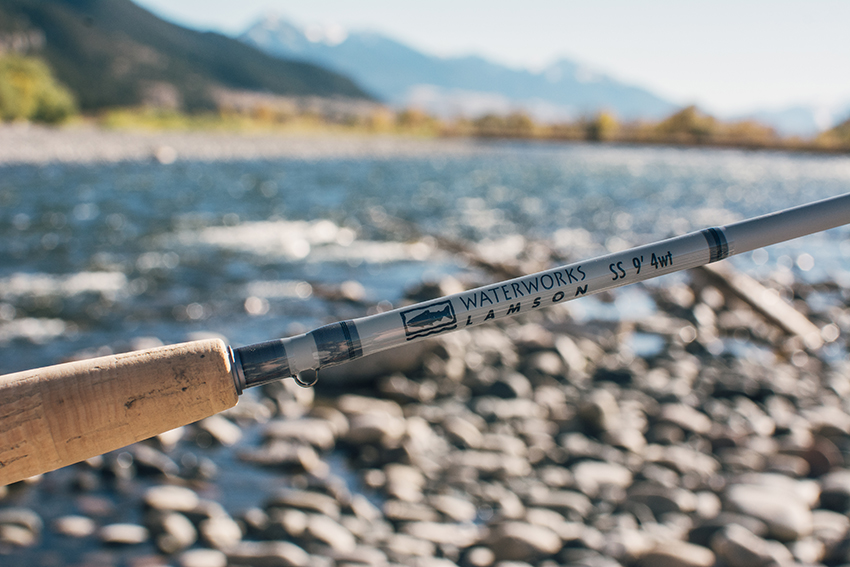

This is a good-looking rod finished in a matte gray color. I just wish that the performance was as good as its looks. One thing that killed its performance scores was the very heavy swing weight. In our important swing weight category, this rod was one of the worst. This is a medium action rod, and slower action rods like this SS have never performed well for us. As you have seen, the best rods in this 4-weight Shootout are medium fast or fast action rods with softer tips.
Overall the craftsmanship was ok but not nearly as good as the best mid-priced rods like the DXF or the Recon. The matte gray blank does look nice, and the guide wraps are a dark gray, trimmed in black on the butt section. The epoxy coatings are pretty good but a little heavy. The handle is a half wells design and the quality of the cork is decent – better than what we saw on the Loop Q and the TFO rods. The reel seat is a simple gray anodized double uplocking, solid aluminum seat with sliding band. I found the rings harder to grip than most and without any nylon spacer they will likely loosen up more easily than other rings with them.
Guides start with a hook keeper, and then one SiC stripping guide, followed with black hard chrome snake guides. I liked the use of alignment dots.
The perfect line: SA Amplitude Smooth Infinity in WF-4-F
George’s casting notes:
Performance at 25 feet: 17.5 points out of 20
Not so good in close. Little feel, and the slower action kills any accuracy.
Performance at 40 feet: 17.5 points out of 20
No better at mid-range. Now I can really feel the heavy swing weight. This is not a pleasant rod to do a lot of false casting with, as you would fishing dry flies.
Performance at 60 feet: 7.0 points out of 10
I could hit this distance easily enough, but I had much better feel and accuracy with the faster, lighter rods.
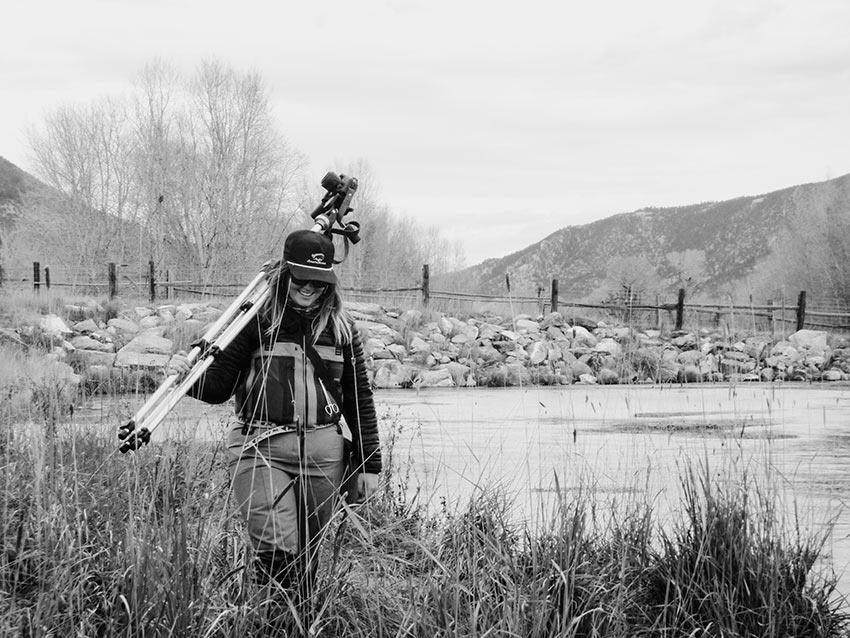
Click here to read Chloe’s comments
We appreciate your support!
These Shootouts take a lot of time and effort. With your support we can continue to give you more Shootouts and head to head comparisons on tackle and equipment in the future. So if you like what we are doing, the best way to thank us is to buy a rod, reel, or outfit from the Yellowstone Angler.
Our thoughts About a Purchase
If you are thinking about buying a fly rod, we suggest reading one of our Shootouts for the line size rod you want. You’ll find these on our Yellowstone Angler home page at yellowstoneangler.com.
If your favorite local shop stocks the rods you are interested in, by all means visit them, try a few rods and purchase an outfit from them.
If you cannot find or cast the rods that interest you, we are here to help. Call us at 406-222-7130, or e-mail us at staff@yellowstoneangler and we can discuss your needs and wants. I’m confident that we can come up with the perfect rod or outfit that best fits your needs.
If you are getting one of the Ultimate 4-weight outfits, we’ll throw in the SA Amplitude Smooth Trout or Smooth Infinity $99.95 line for free, and also ship it to you for free! And since we are in Montana, there is no sales tax.
Once you get your new rod or outfit, do some casting on the lawn, and if you feel it is not just what you want, (and has not been fished), we’ll allow you to return it to us for a full refund, less the shipping charges.
Use this link to go to our Favorite Freshwater Outfits for the 3 through 8-weight rods, in our Online Store. Here you’ll find our recommendations in three price ranges: The Ultimate Outfit, Mid Priced Outfit and Best Buy Outfit.
If you are looking for that perfect saltwater outfit, then use our Favorite Saltwater Outfits link.
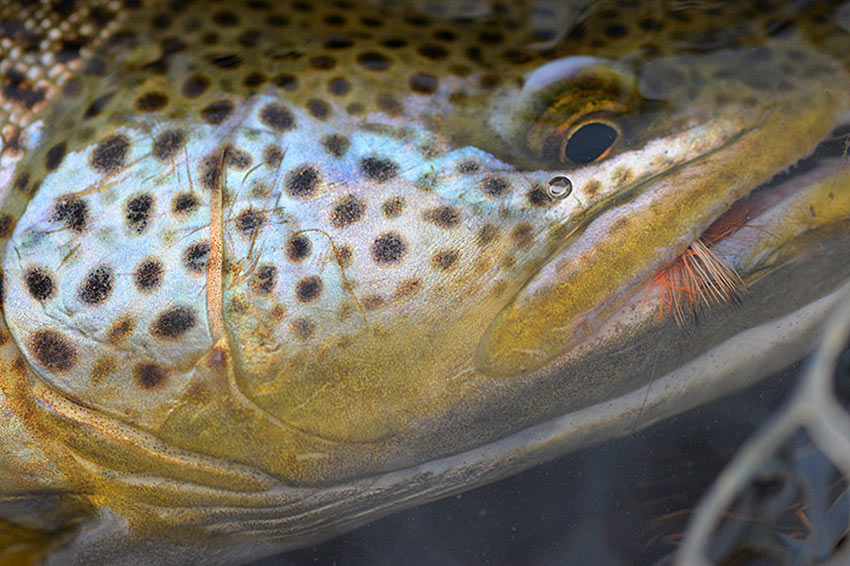
If you get to Montana, we invite you to stop at our shop and do your own rod comparison right here on our lawn. We have several reels rigged with the various line sizes, and leaders, all ready to go. We’ll come out with you and give you some help to fine tune your casting stroke, or just help you with the basics. And once you’ve picked out the perfect rod, stay and enjoy a few days on the water with one of our top guides.
We value your comments about the Shootout and invite any questions you might have about it or your tackle needs. We have fished all over the world in both fresh and saltwater for a variety of fish, and we’ll be glad to answer all of your questions, to help you choose the perfect rod or outfit.
– George Anderson, and the rest of the Yellowstone Angler crew